SEO
All You Need to Know to Get Them

Do you want to jump to the first position in Google without building links or significantly updating your content? Featured snippets can help you with that.
Featured snippets are a special type of search result showing a quick answer to the search query at the top of Google’s results page. Google pulls this information from one of the top-ranking pages that then gets elevated to the top of the organic search results this way.
You may be wondering how that’s a good thing for the website that owns the featured snippet. Users see your content on the SERP, and that may mean losing clicks, right?
Well, yes and no. Check this example:
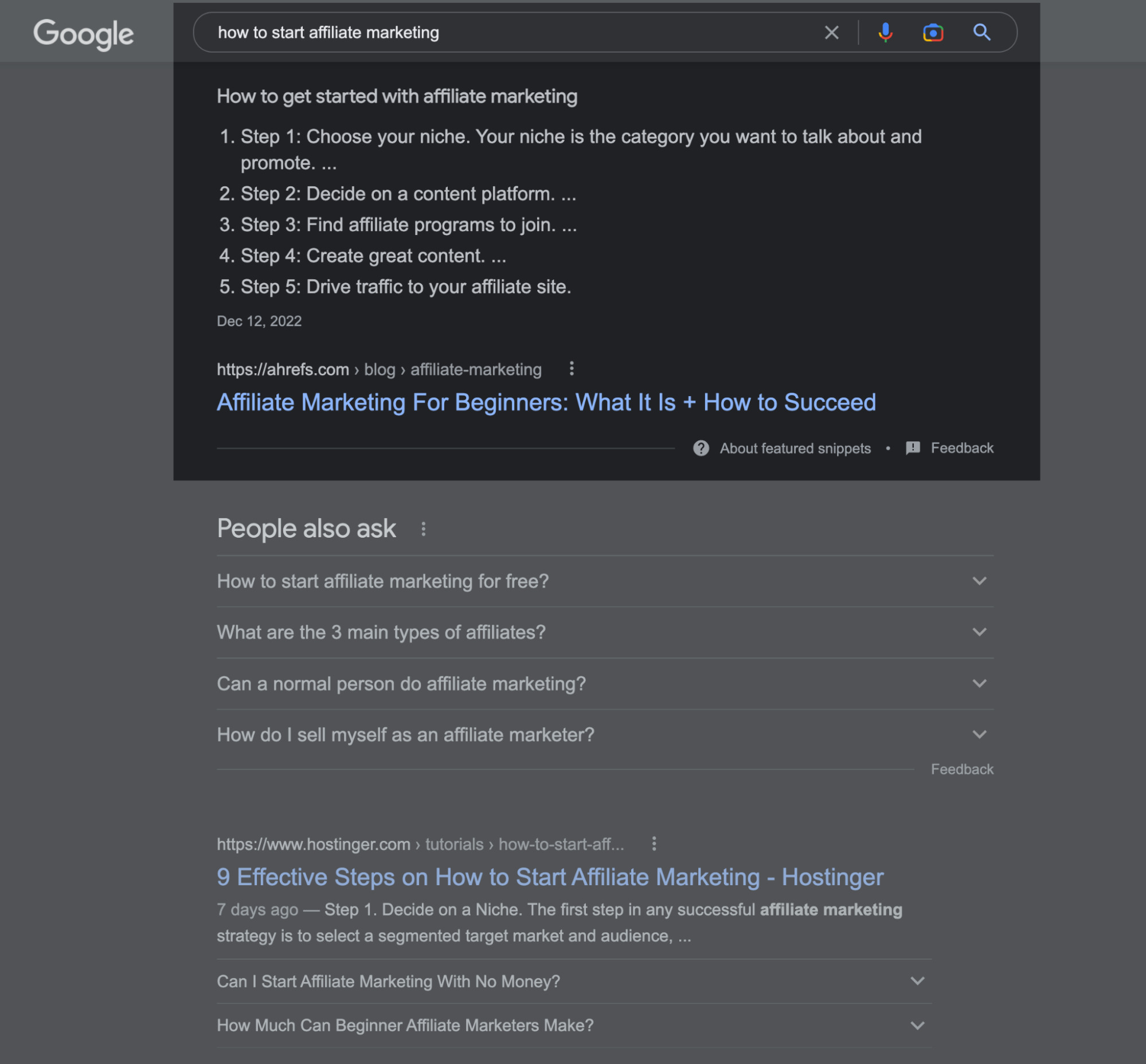
If this question were possible to answer thoroughly in a few sentences, most of us would be out of work. So while the snippet tells you the absolute basics, you still have to click to learn more.
That’s just one example. Featured snippets are one of the most prominent SERP features—and they’re evolving all the time.
Follow this guide to learn everything you need to know about featured snippets and what it takes to optimize for them.
There are five types of featured snippets that Google shows depending on the intent behind the search query:
- Paragraph
- Numbered list
- Bullet list
- Table
- Video
Let’s check an example for each type.
1. Paragraph
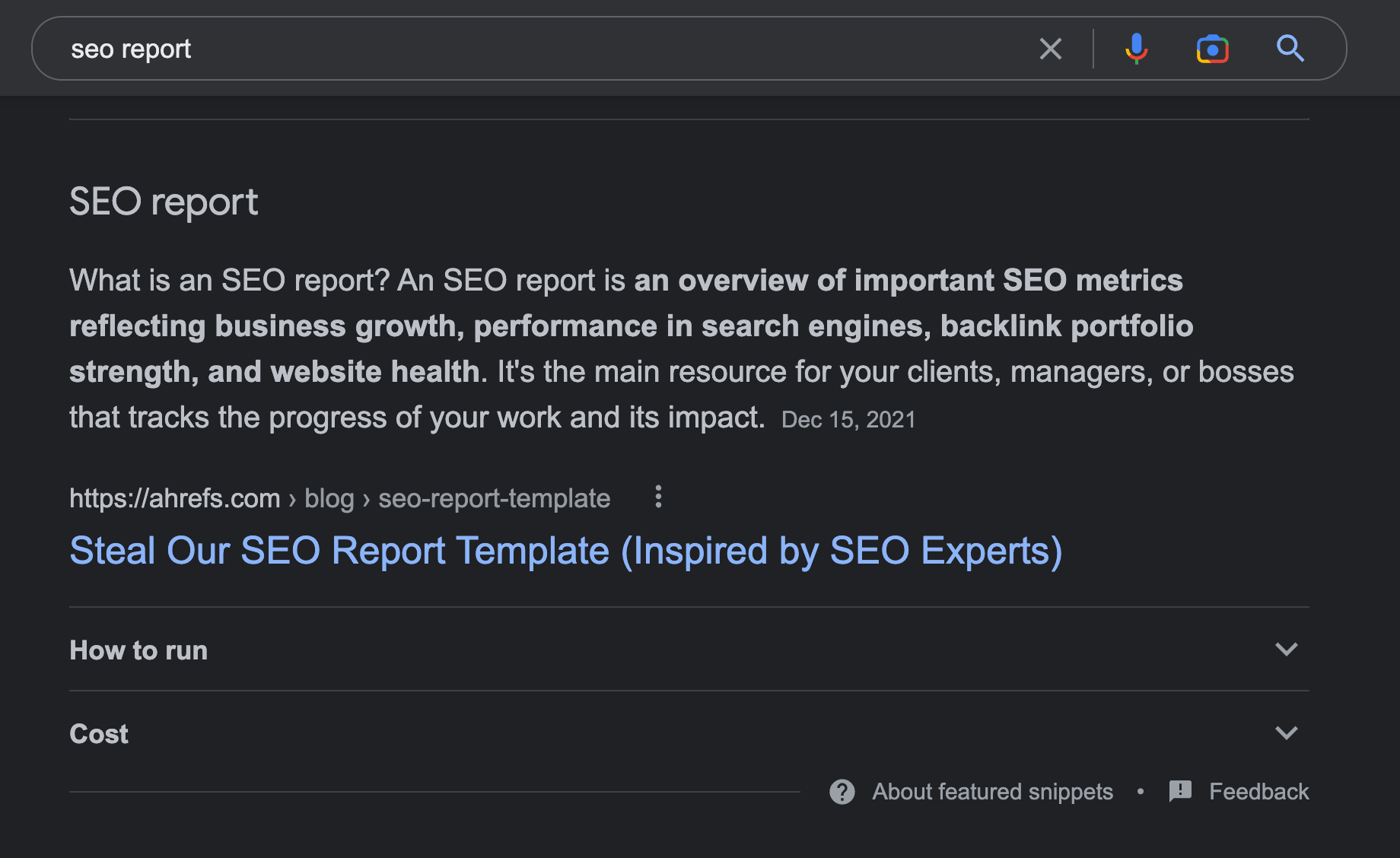
This one is a bit special because Google sometimes combines featured snippets with People Also Ask (PAA) boxes. You can see additional questions related to the search query there and click on them to see more information. That often comes from a different source than the featured snippet itself, as you can see in this case:
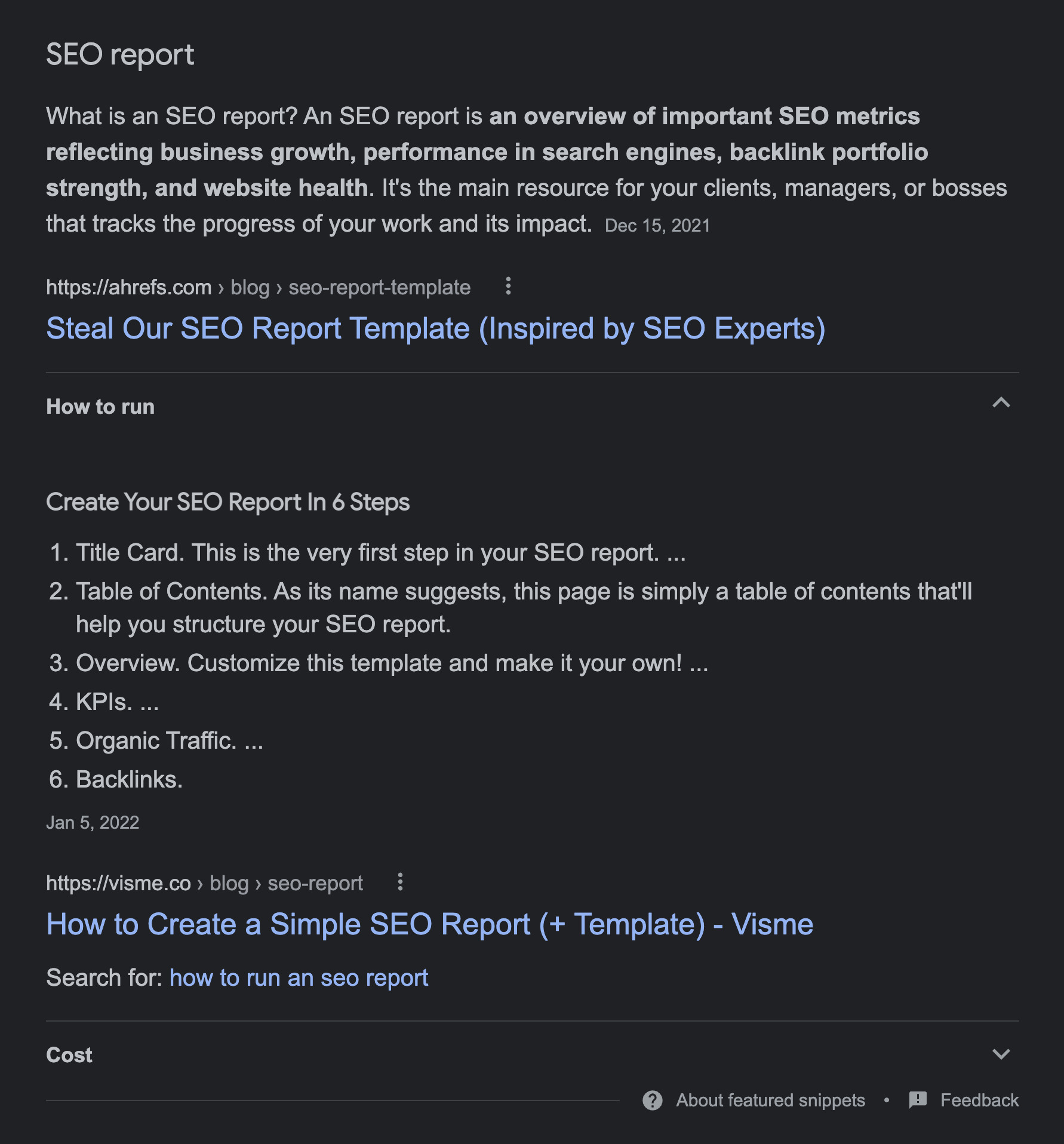
2. Numbered list
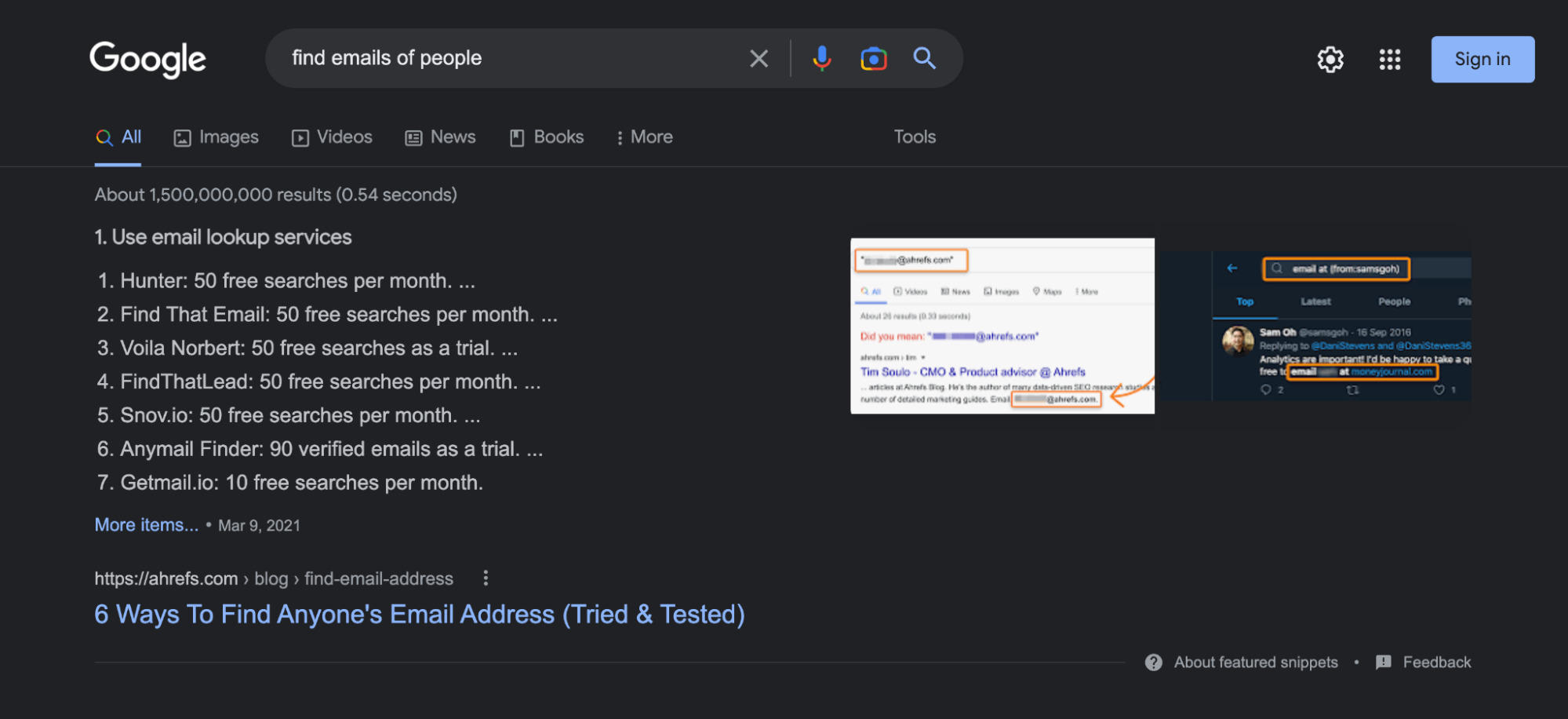
3. Bullet list

4. Table
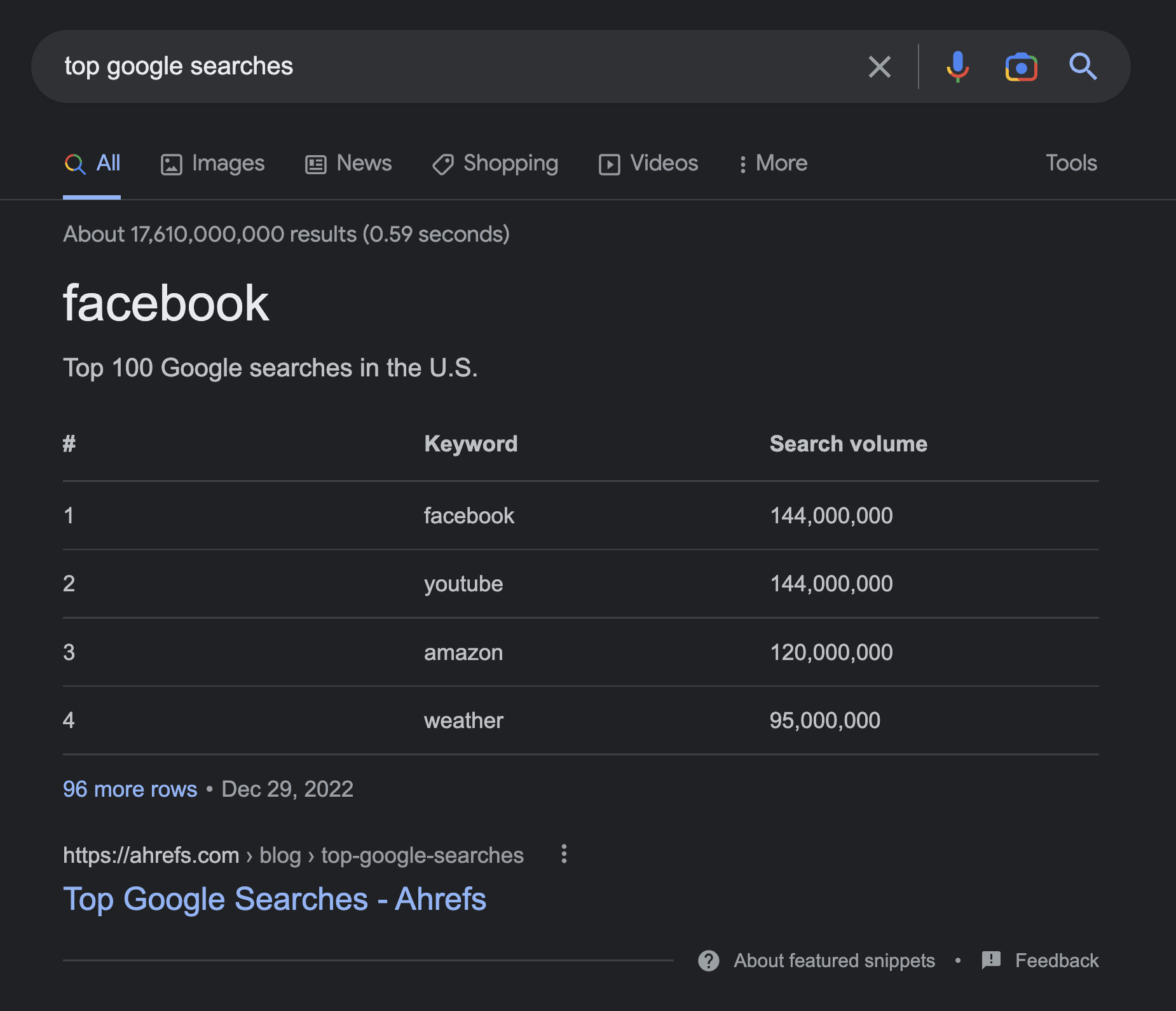
5. Video
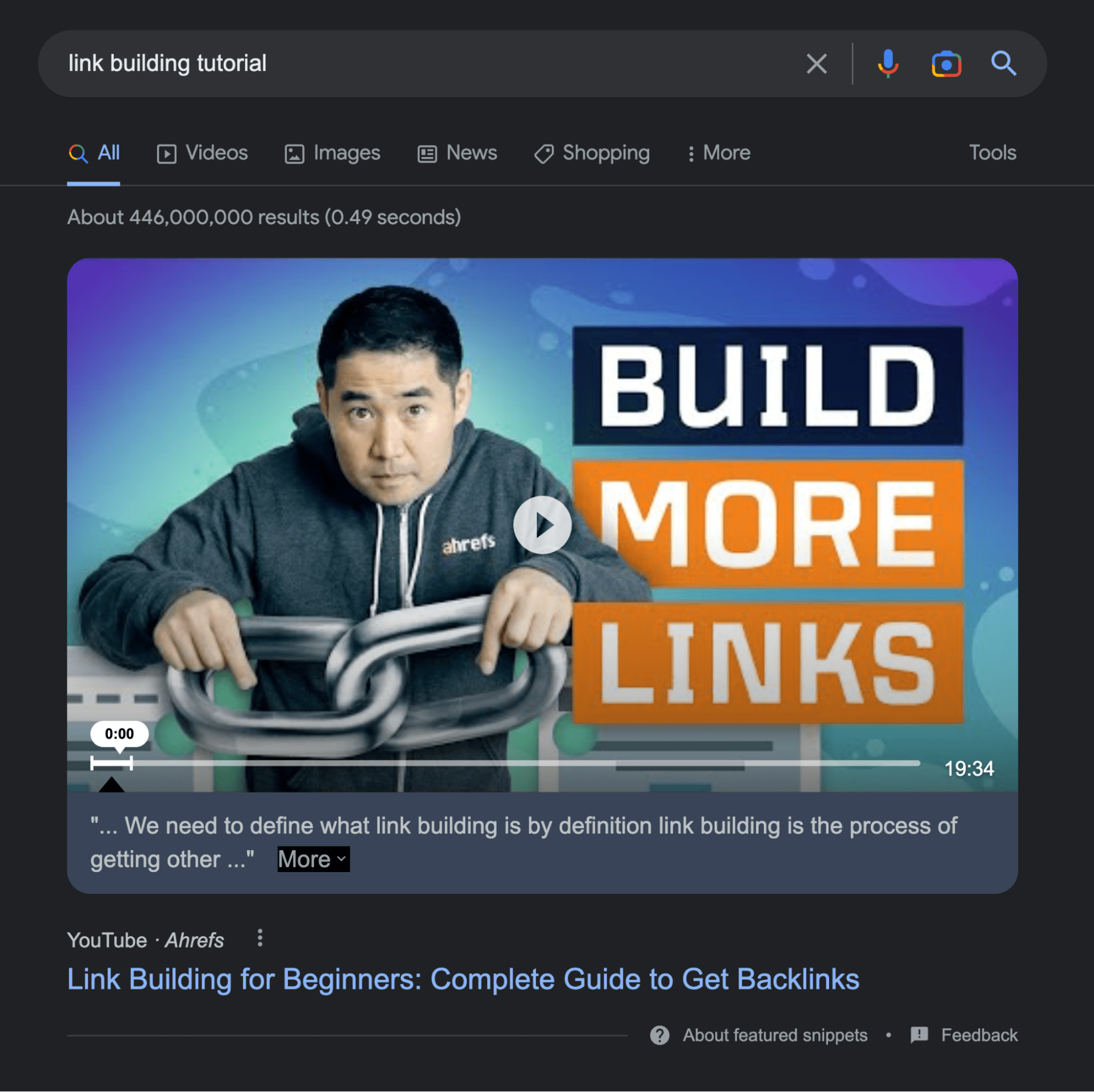
It’s also important to note that there are other “snippet-like” results. You need to know about these to avoid any confusion:
Knowledge panel
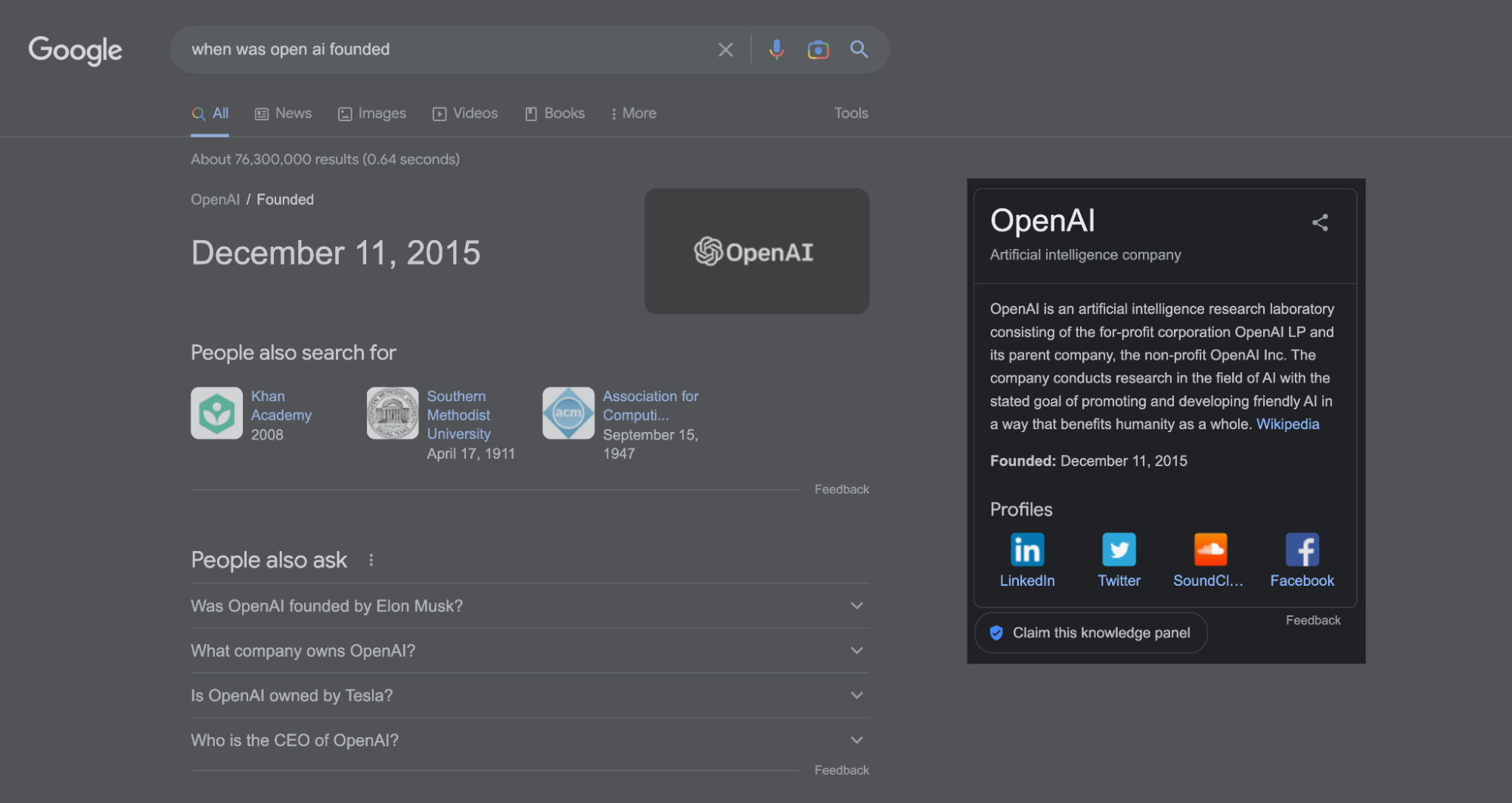
Knowledge card
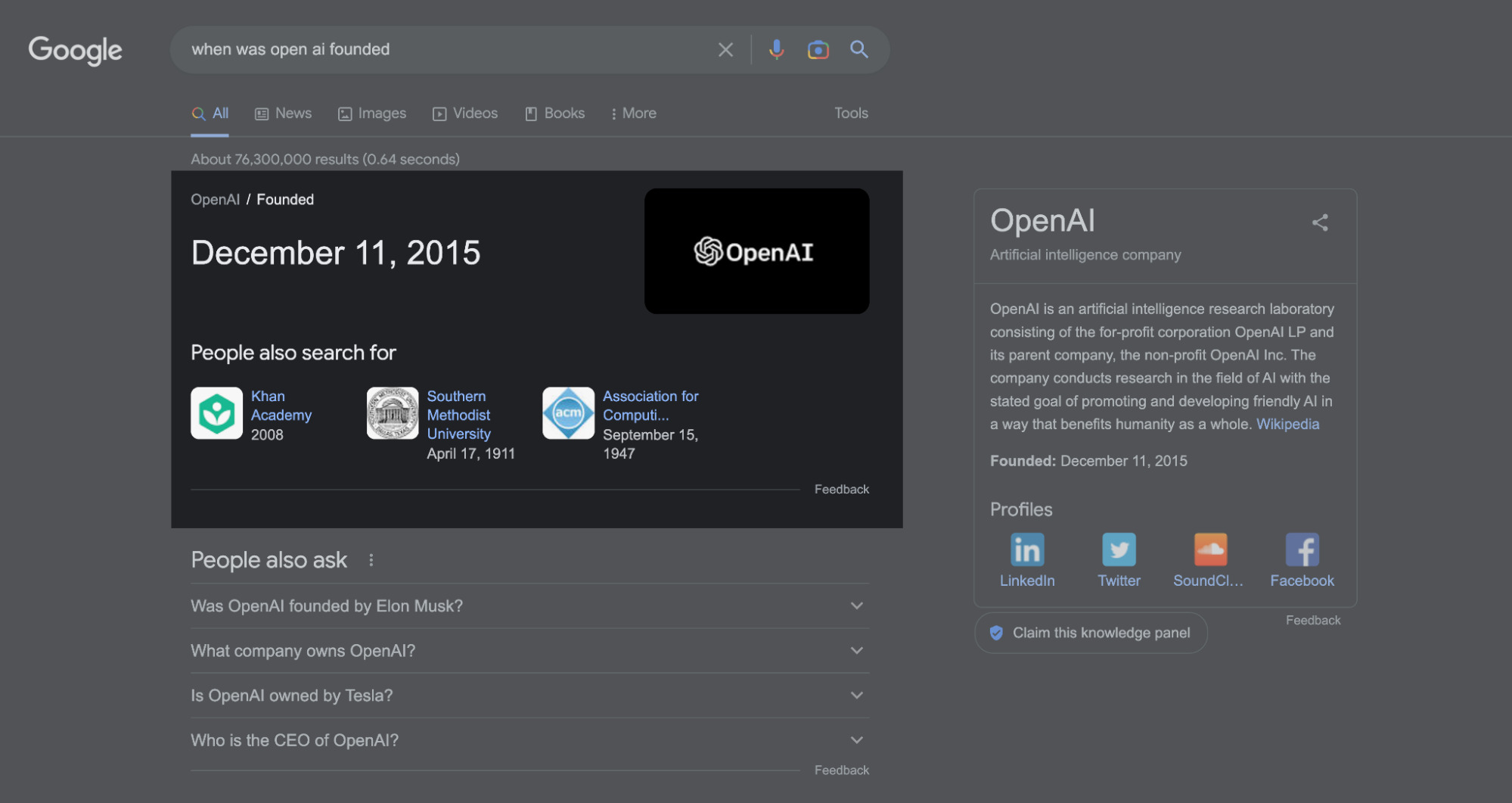
Entity carousel
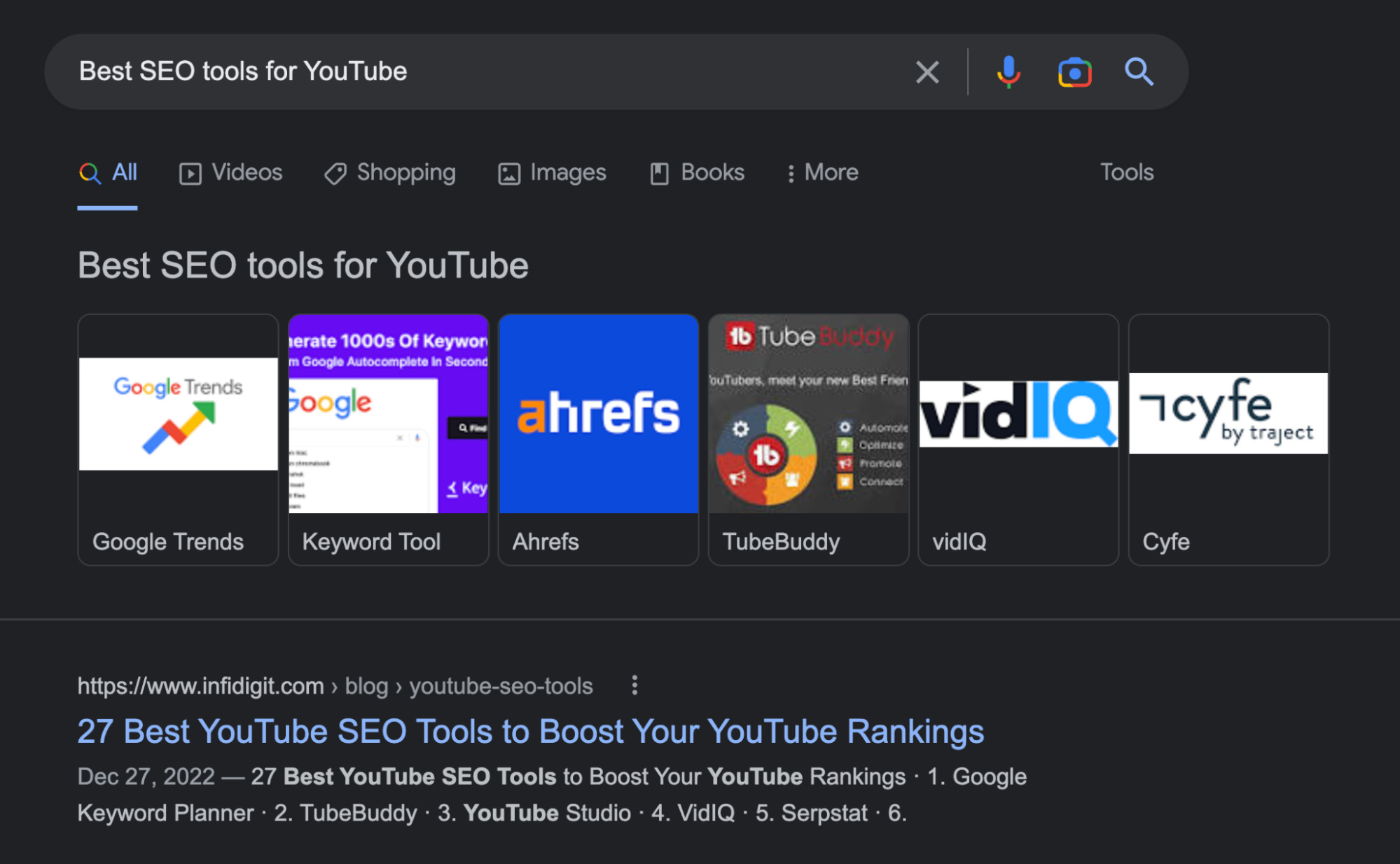
These three SERP features have one thing in common. They don’t pull answers from just one of the top-ranking search results, as they’re based on entities in the knowledge graph. While they may contain a link to the source of information (song lyrics, for example), it’s never in the form of a clickable title as we have in featured snippets.
Google introduced featured snippets in 2014, and I would say that they’re one of the most prominent SERP changes of the past decade. There are quite a few things that featured snippets changed for both users and SEOs.
Shortcut to the top organic position
If your content is ranking on the first SERP for a search query that shows a featured snippet, you can “win” that snippet and shortcut your way to the top position. Let’s break this down.
Our study found that featured snippets come from pages that already rank in the top 10. Moreover, the vast majority of featured snippets pages rank in the top five.
In conclusion, the higher your content ranks, the more likely it is to get a featured snippet.
Getting to the first SERP is a more manageable goal than ranking number #1 for a keyword. But if that keyword triggers a featured snippet, it makes the first position a bit more attainable.
Fewer clicks… sometimes
In the past, the page owning the featured snippet would also be listed in the standard “blue link” search results somewhere on the first SERP. But in January 2020, Google introduced featured snippet deduplication.
Once your page gets elevated to the featured snippet, you lose that “regular” search result.
Besides the little traffic losses back then, some people also think that featured snippets reduce clicks on the search results. After all, if the answer to the query is on the SERP, why would you click on a result?
While this is the case for some queries, it’s certainly not the case for them all. It depends on whether Google can provide a satisfactory answer in the snippet.
For example, take a look at the featured snippet for this query:
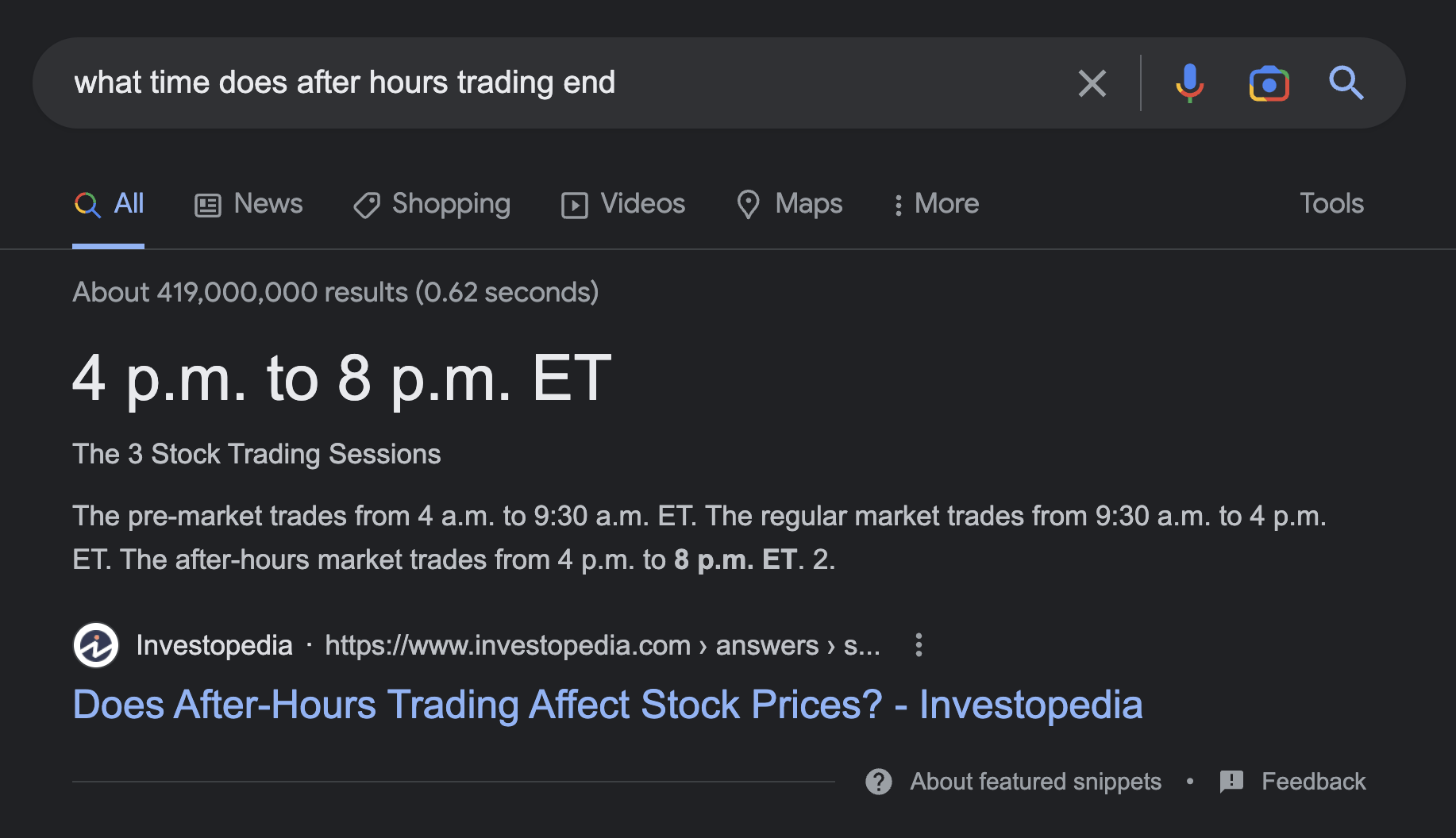
The answer is right there for most people. And that’s why there’s only a 19% chance, on average, that the search for this query results in a click.
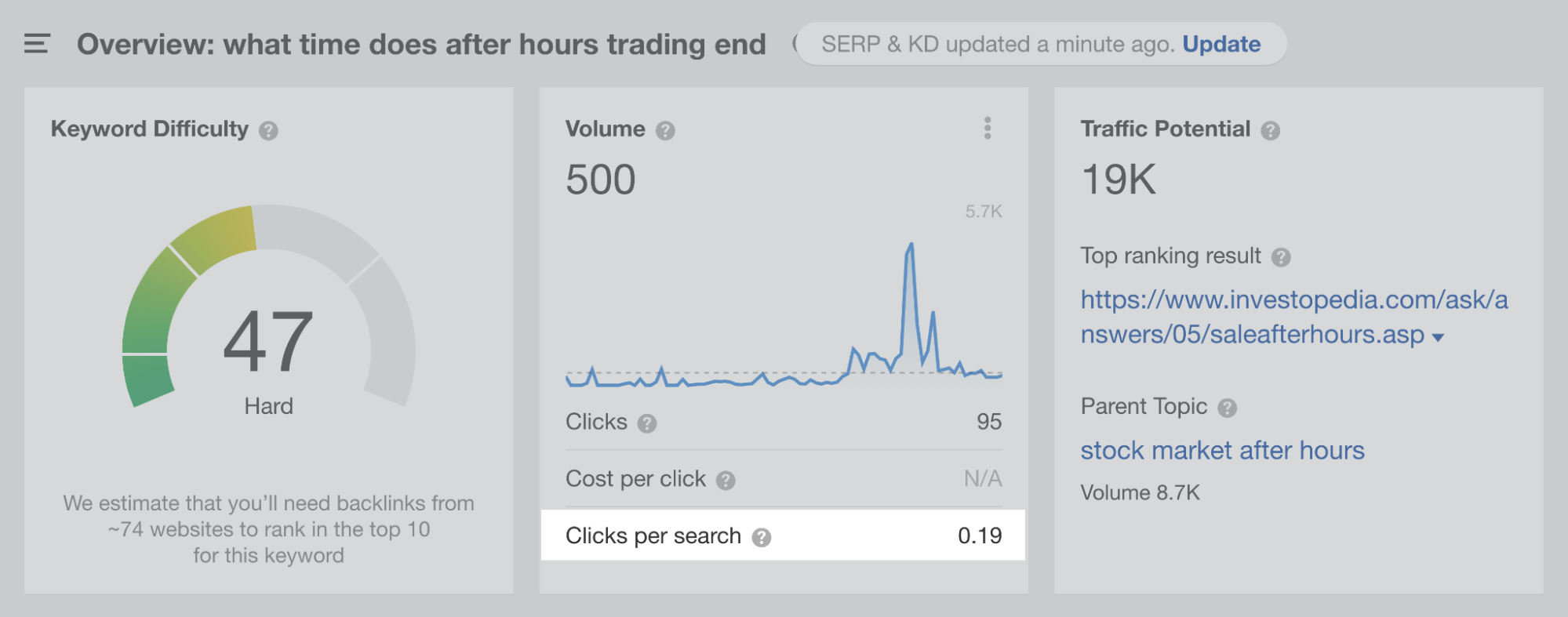
Now take a look at the snippet for “how does the stock market work”:
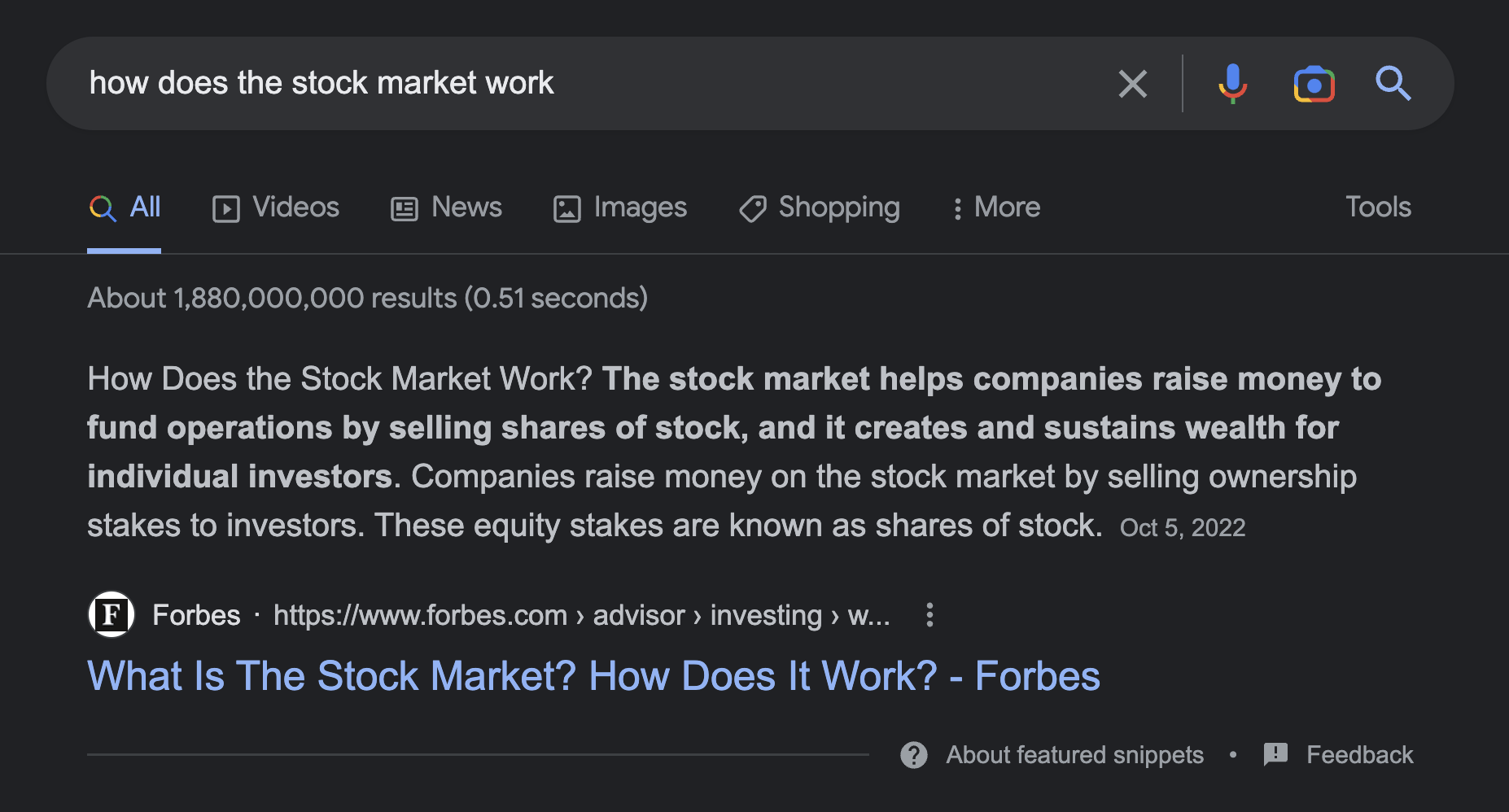
Because it gives a basic answer to the question, most searchers will probably want to know more.
That is most likely why, on average, 82% of searches for this query result in a click.
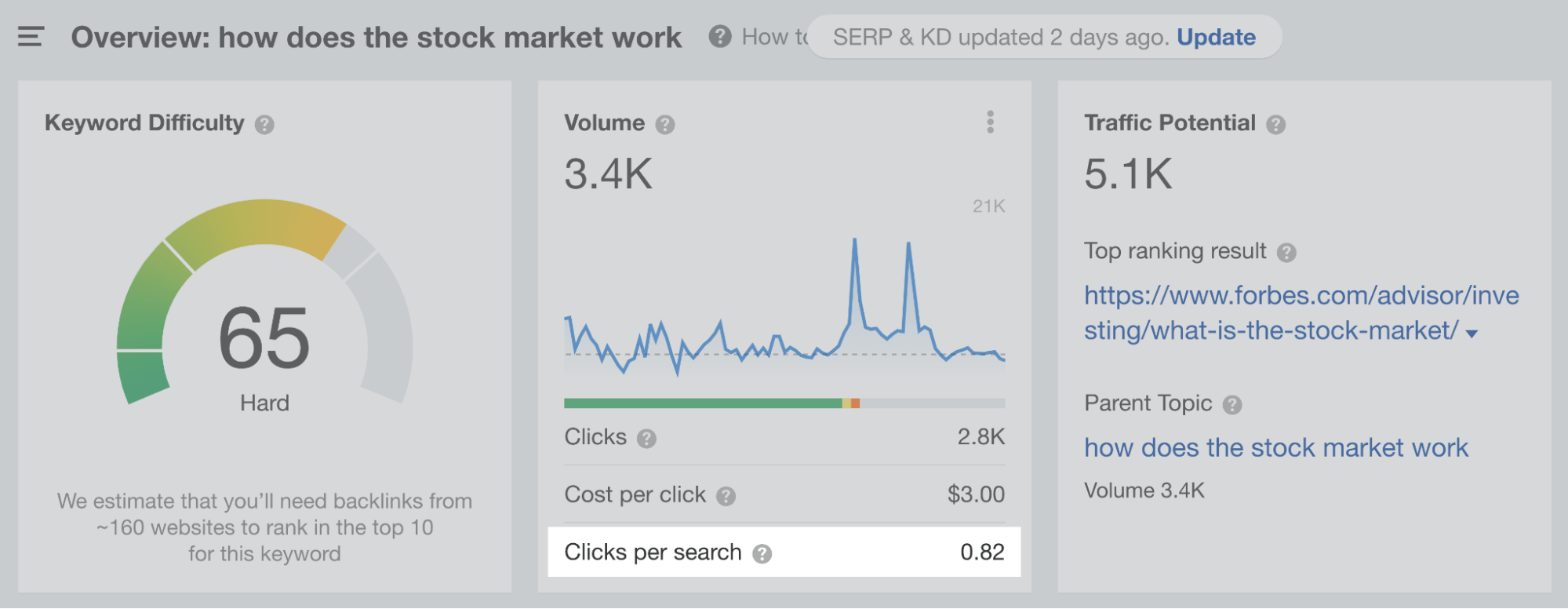
The takeaway here is that targeting keywords with a low number of Clicks Per Search (CPS) is rarely a good idea.
Pay attention to this when researching keywords in Ahrefs’ Keywords Explorer.
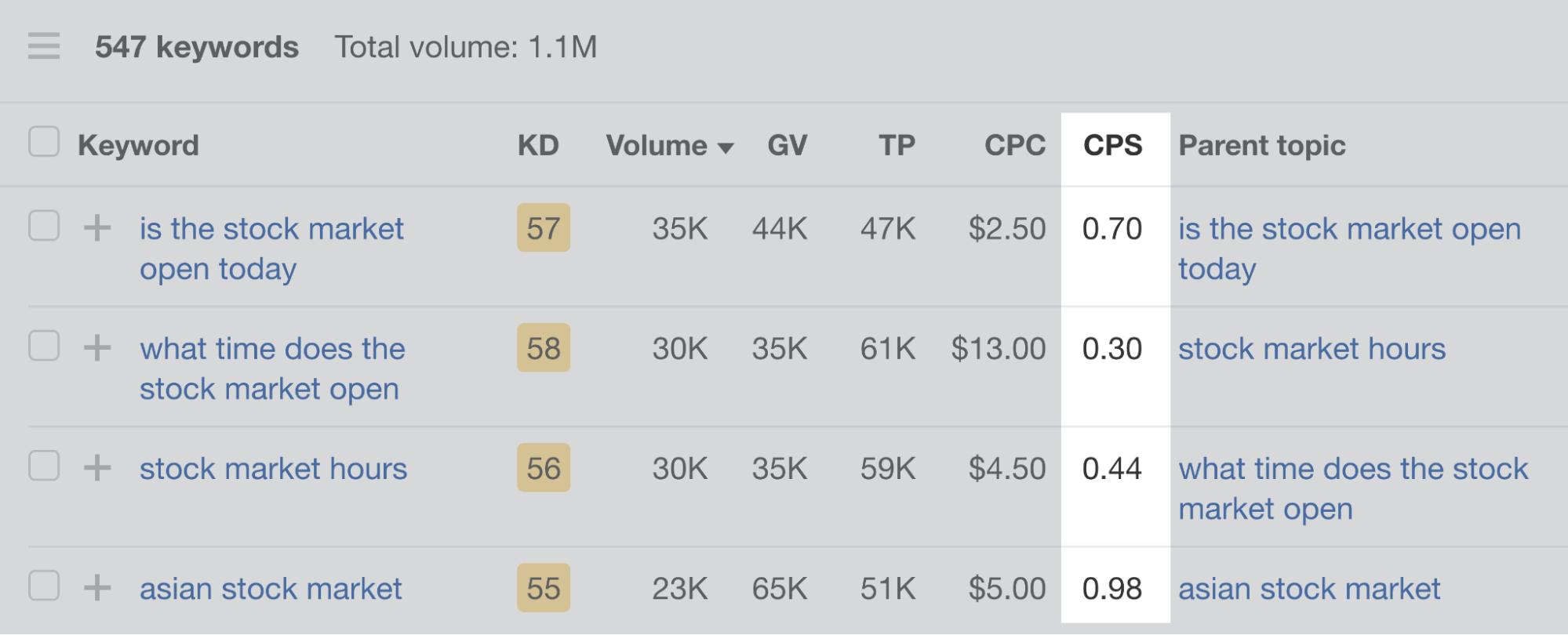
Featured snippets as superb branding opportunities
Clicks aside, featured snippets are the first thing that users see in the search results if there are no search ads. They’re even more prominent on mobile devices where they’re often the only thing people initially see:
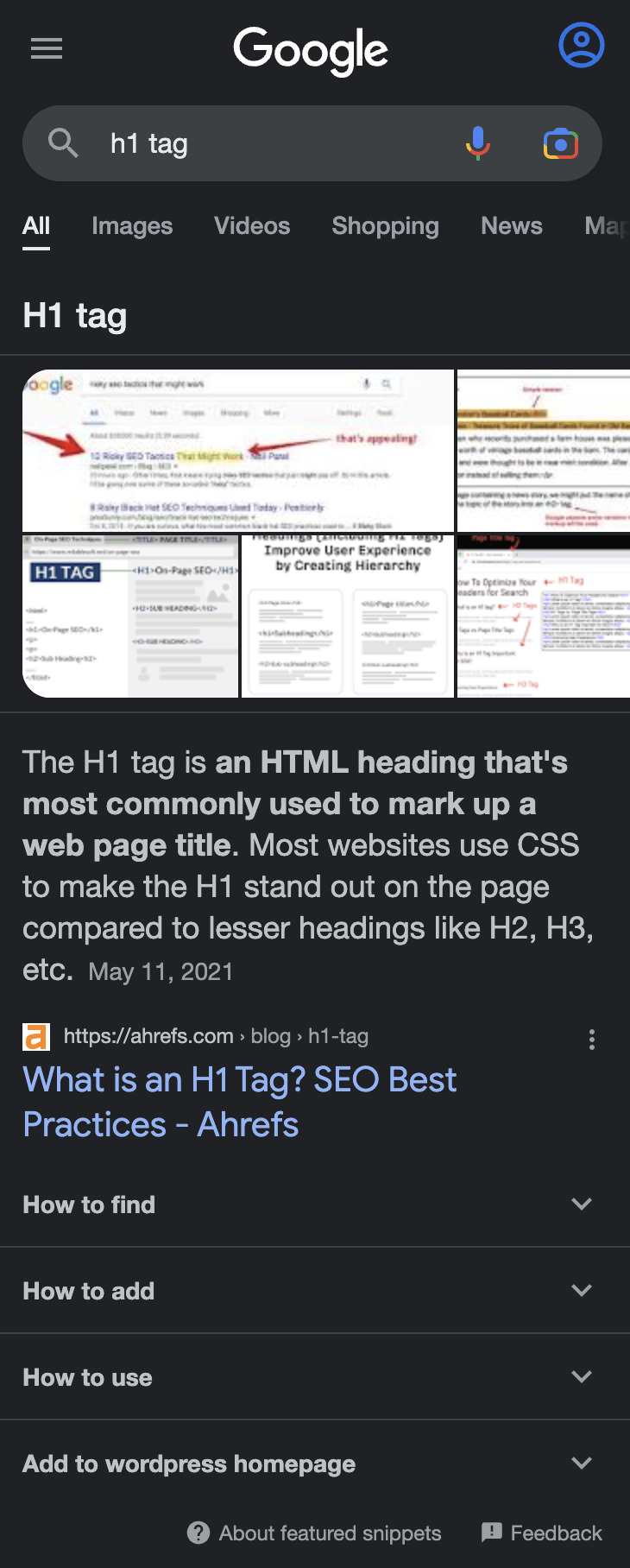
This is a very compelling argument in favor of featured snippets.
Increasing your share of voice on the SERPs is arguably one of the most important SEO KPIs. That’s because brand-building is proven to be the primary driver of long-term growth.
The more your brand is visible on the SERPs for relevant topics, the more you will be associated as a market leader.
You can opt out of featured snippets (don’t do that, though)
Cyrus Shepard led the way in experimenting with opting out of featured snippets after the SERP deduplication and discovered that it led to a 12% traffic loss.
That said, if you still want to opt out of featured snippets, Google offers various ways to do that. Just be aware that both nosnippet robots meta tags methods also block your content from appearing in traditional “blue link” snippets. I don’t recommend using those because Google could then only use your hard-coded title tag and meta description.
So the best way to remove your page from appearing in featured snippets is to include max-snippet robots meta tag. This tag specifies the maximum number of characters Google can show in the text snippets.
And because featured snippets are longer than descriptions in regular snippets, you can set the character limit to the usual maximum length of descriptions. That’s around 160 characters.
You’ll just have to paste this code snippet into the <head> section of the page that you wish to remove from the featured snippets:
<meta name="robots" content="max-snippet:170">
While this method doesn’t guarantee not appearing in shorter featured snippets, it still outweighs the cons of using the more restrictive methods.
Recommendation
For example, here’s a featured snippet that we own:
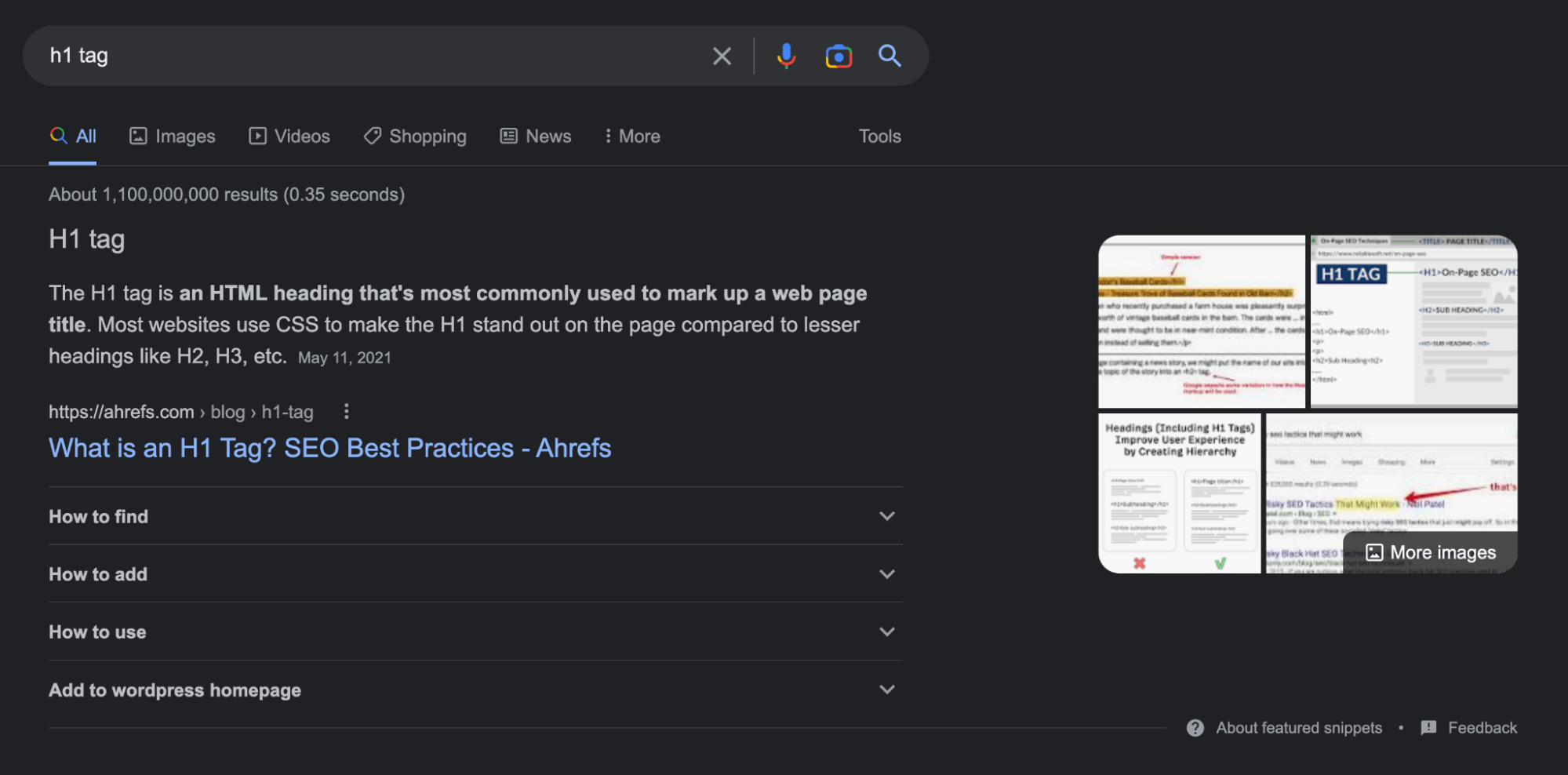
If we appended “&num=9” to the URL, preferably in Incognito mode, we can see where we’d rank if we weren’t in the snippet:
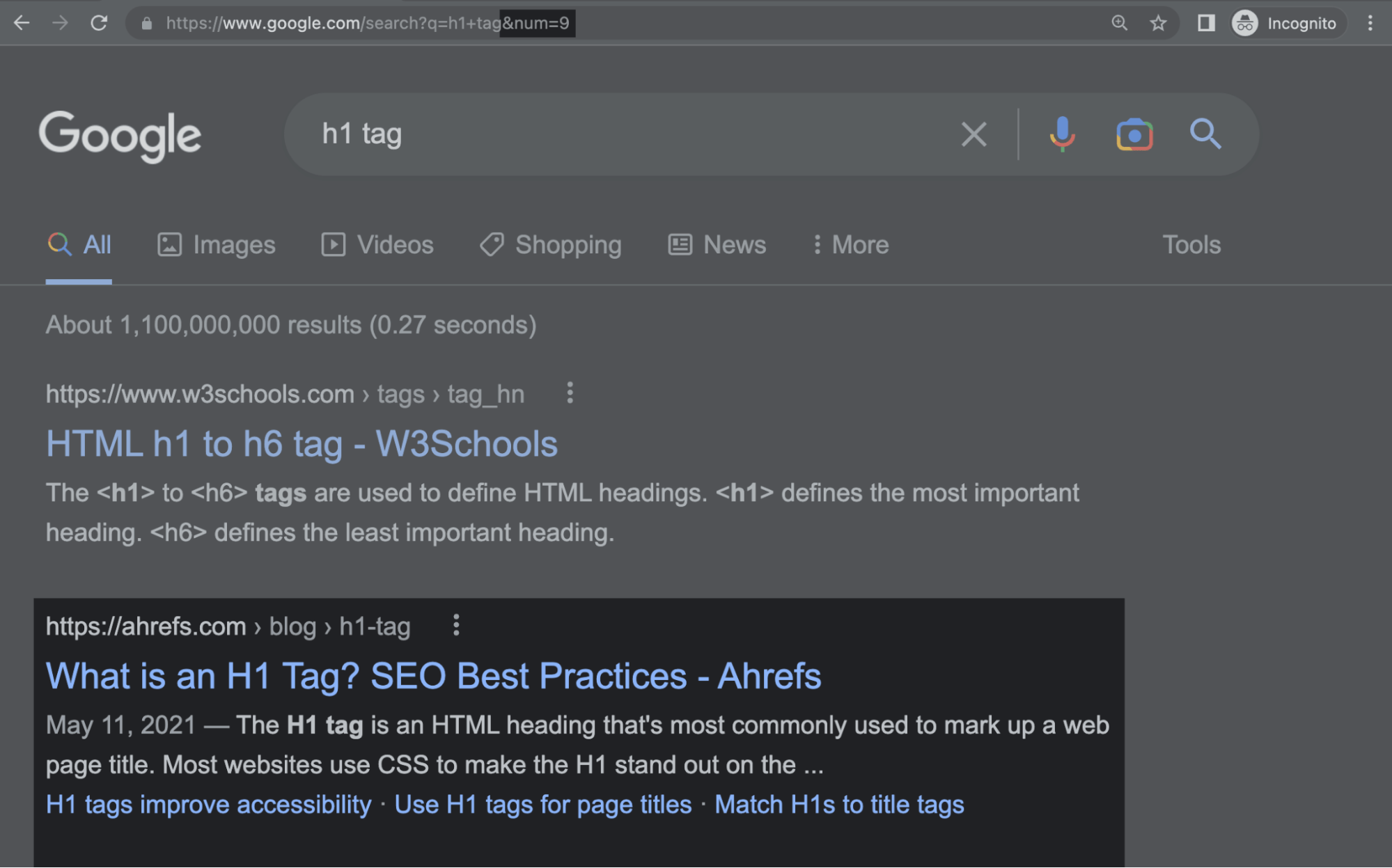
In this case, if we decided to opt out, we would be in the second or third position—depending on the page that would take over the featured snippet (you’ll see how to do that too).
Being in lower positions and opting out can hurt your traffic. You’ve been warned.
Google Search Console doesn’t show any information regarding featured snippets. You’ll have to use third-party tools like Ahrefs’ Site Explorer to dig into them.
Let’s stick with Site Explorer. Paste in your site, then head to the Organic keywords report to see the keywords you rank for, then filter only for those where Google shows your page in the featured snippet:
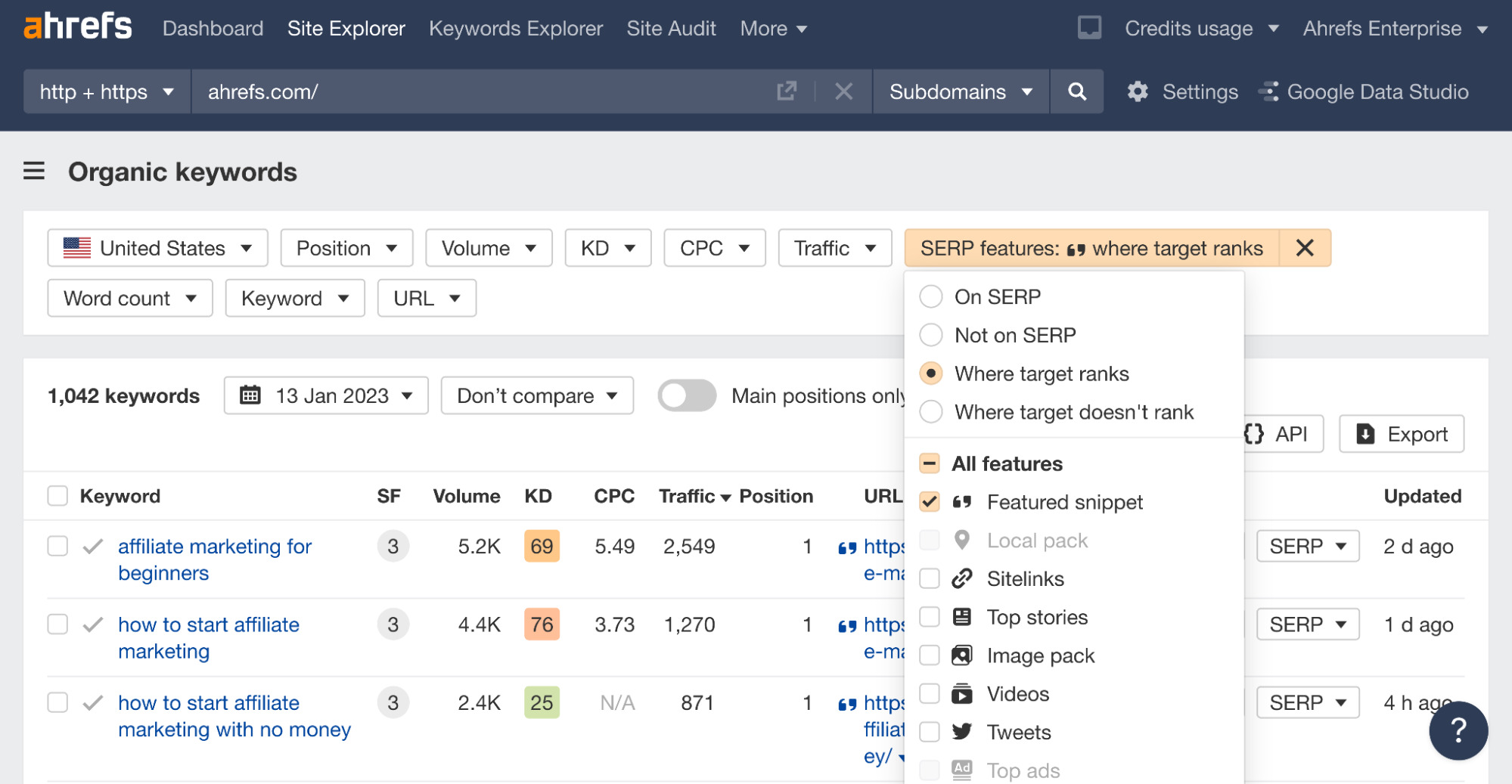
As you can see above, Ahrefs’ domain currently ranks for 1,042 keywords with featured snippets in the U.S.
In the previous version of this article, I recommended filtering for keywords with the highest search volume and checking the most important featured snippets manually. That’s because Google sometimes pulls content that isn’t optimal, and you’d want these important featured snippets to be perfect.
However, Google is still improving. Now, I didn’t find a single keyword where I’d bother editing the section Google pulls it from.
While you may come across featured snippets that can do with a bit of polishing, I don’t recommend editing things unless Google pulls poorly formatted, misleading, or just plain wrong information.
It’s better to own an imperfect featured snippet than to risk losing it to a competitor by revising it.
Winning more featured snippets is a simple way to potentially increase organic traffic to your site. Below, we’ll discuss a few ways to do that.
Leverage content that you already have and rank for
Here, we’ll be looking at pages that already rank in the top 10 for a particular term yet don’t own the snippet. It’s possible to win the snippet just by making a few tweaks to your page.
How to find these opportunities? It’s easy.
Go to Site Explorer and filter keywords that trigger featured snippets where your website is ranking in positions #2–10.
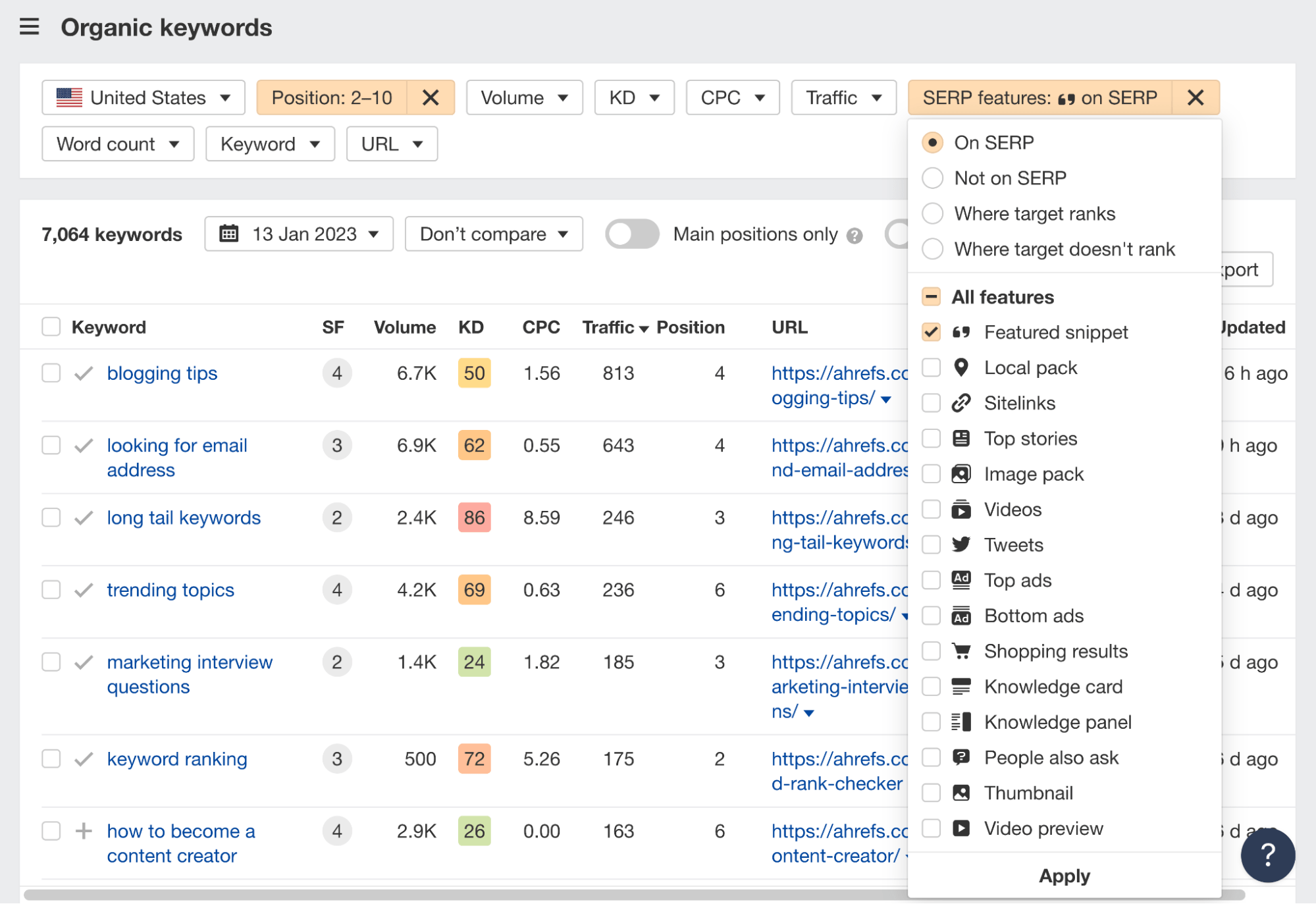
This is an easy way to filter out the vast majority if not all the featured snippets that you rank for, since they’re predominantly ranking at the first position. There are cases where they appear at lower positions, but it’s rare these days. In fact, all of our 1,042 featured snippets are ranking at the first position.
In other words, we now have a list of low-hanging opportunities to steal featured snippets from your competitors. Let’s get you prepared for the heist.
We need to prioritize. Stealing 7,064 featured snippets at once is mission impossible.
I reduced the list to just 21 keywords by prioritizing those with higher search volumes where we rank in positions #2–5.
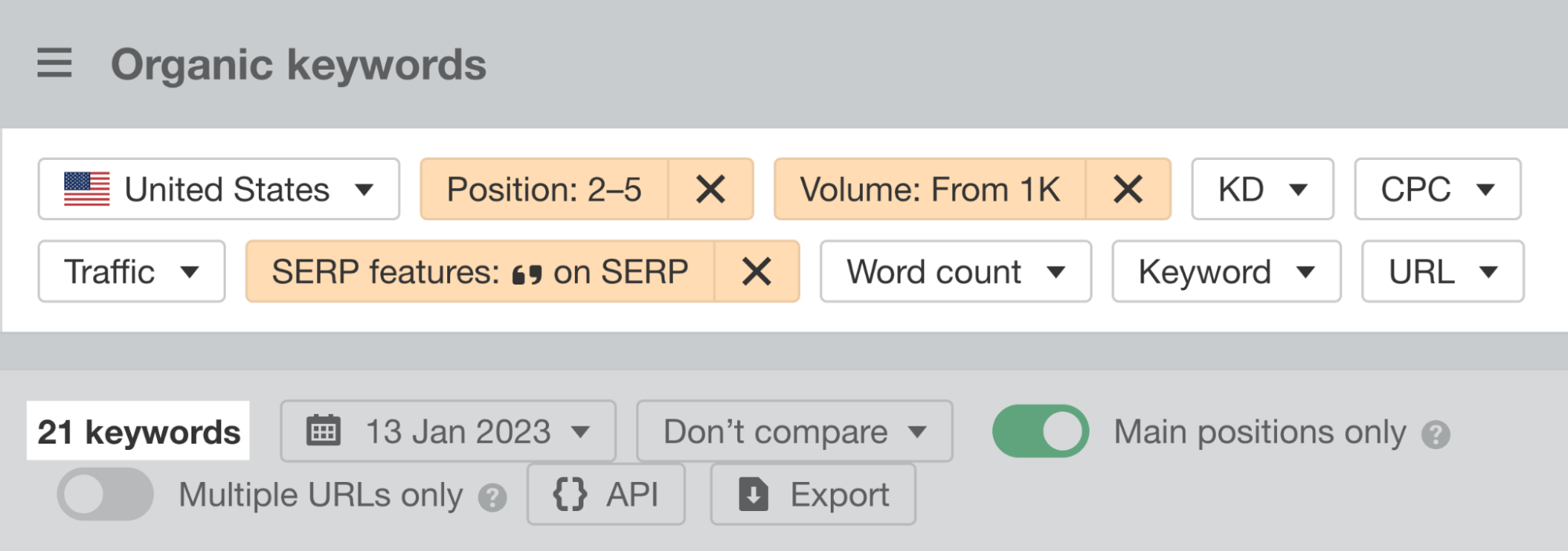
Now things look much more manageable.
The search volume filter is an obvious one, as there’s no point in targeting long-tail keywords at this point. Regarding the positions and referring back to our study, the probability of owning a featured snippet increases with your organic position for that search query.
Again, these filters will be different for you. However, if you don’t rank for a substantial number of keywords already, I’ll suggest focusing on creating more great content and building links.
So we’ve got the list. What’s the battle plan?
In our case, I’ll prioritize further by manually checking for keywords with solid business value. Let’s take a look at some of those keywords:
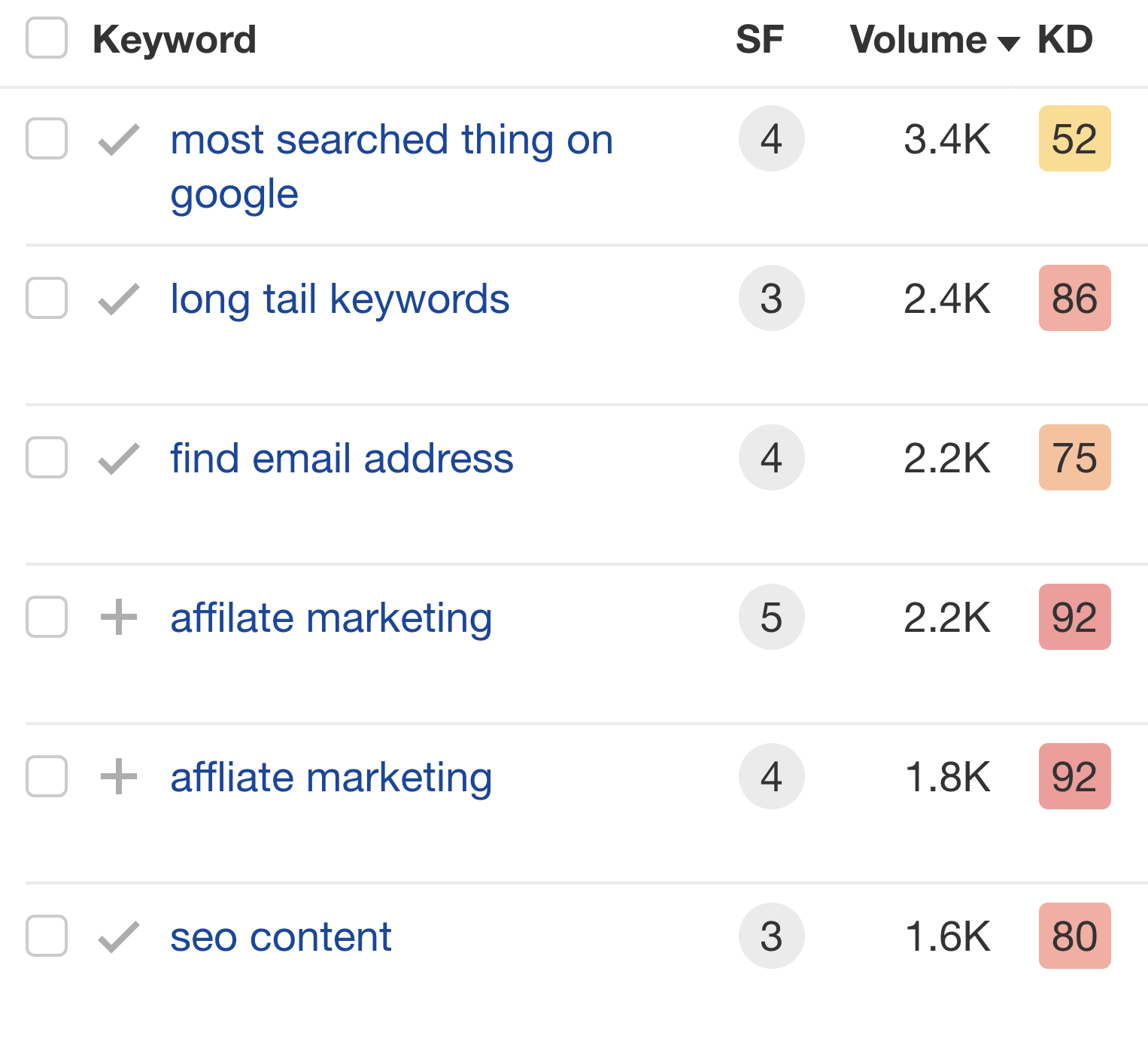
For example, the search query “most searched thing on google” at the top is less valuable for us than “seo content” at the bottom even though the first has twice the search volume. People who want to learn about creating search-optimized content are much more likely to become our customers one day.
Taking that “seo content” query into account, this is what I see:
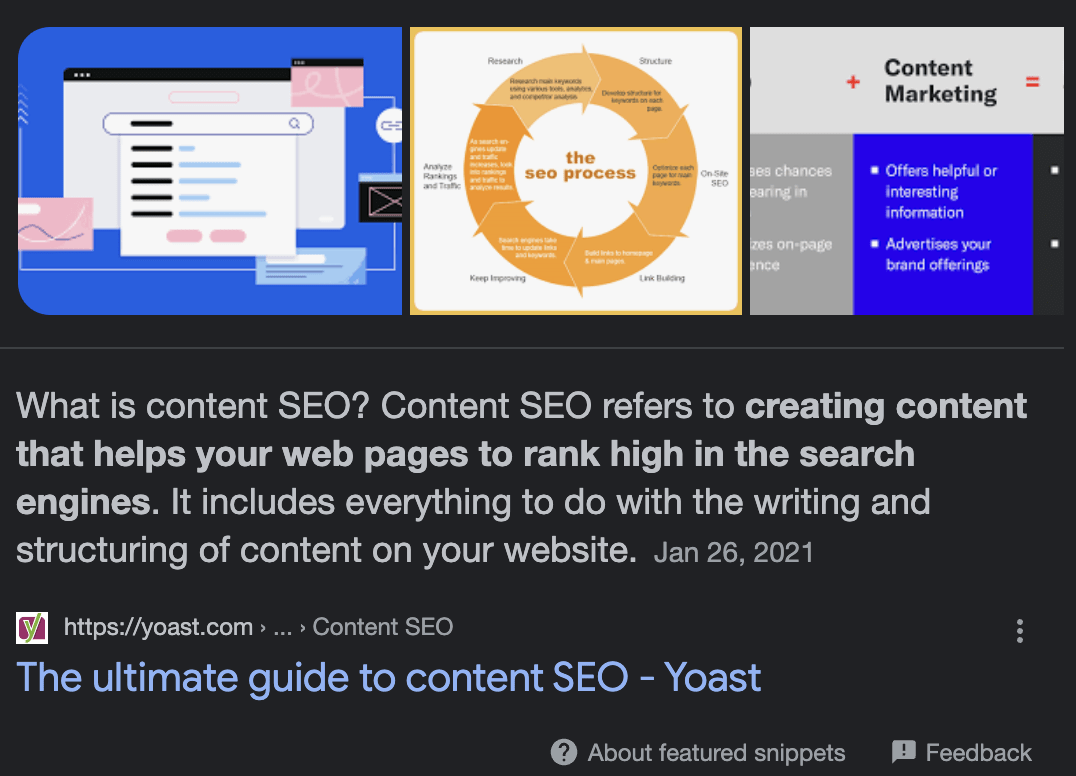
First thing I’ll do here is to check whether our page even qualifies for the featured snippet at the moment. That can dictate how big of a change we need to make. You do that by excluding the domain that ranks for the current featured snippet using the - search operator.

In this case, there’s no other page in the featured snippet “queue,” which is an indicator that we currently don’t provide a good, short answer to the search query in the eyes of Google.
Just so you know, here’s an example of a featured snippet that has other eligible pages in line:
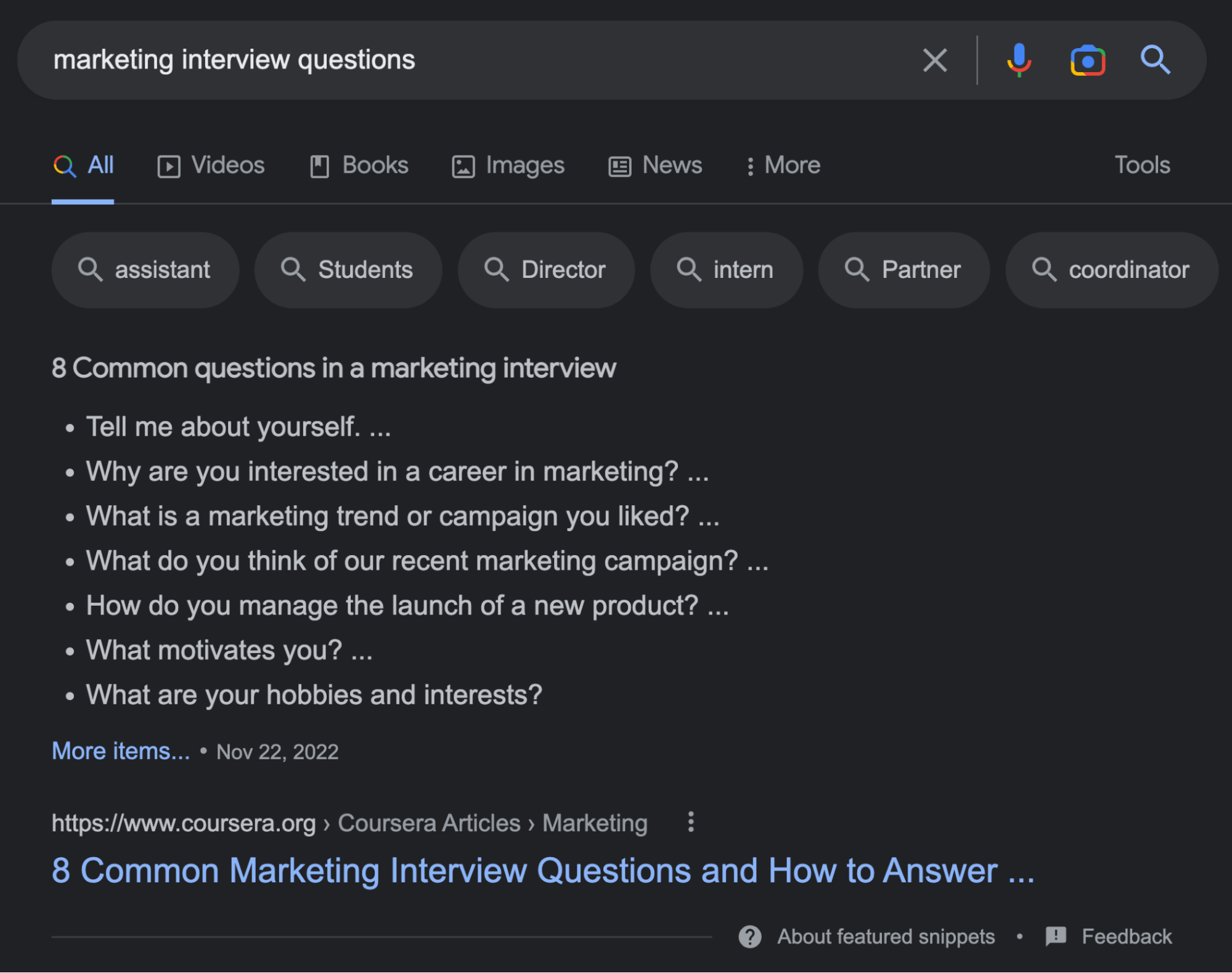
After excluding the Coursera domain, we can see what Google considers as the second-best option:
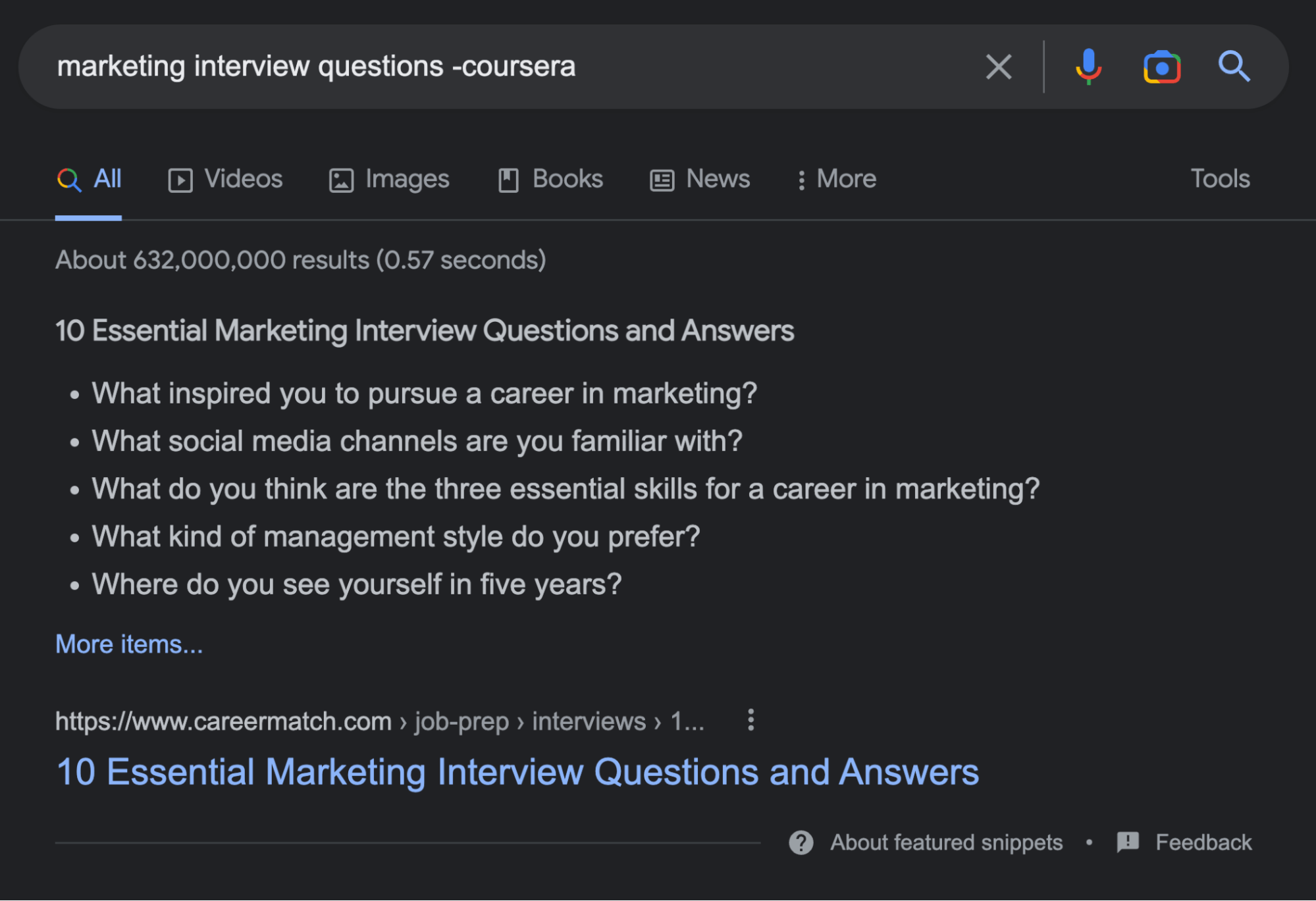
And you can go on to even see the third domain in line, and so on. But back to optimizing for the “seo content” featured snippet.

We can clearly tell that a short, definition-style paragraph is the way to go here. Let’s check what we have in our content:

So the appropriate section exists; that’s a check. An interesting thing here is that Google ranks a page that targets the keyword in reverse order. Let’s see if other pages qualified for ranking there in the past by opening that keyword in Ahrefs’ Keywords Explorer and scrolling down to the Position history:
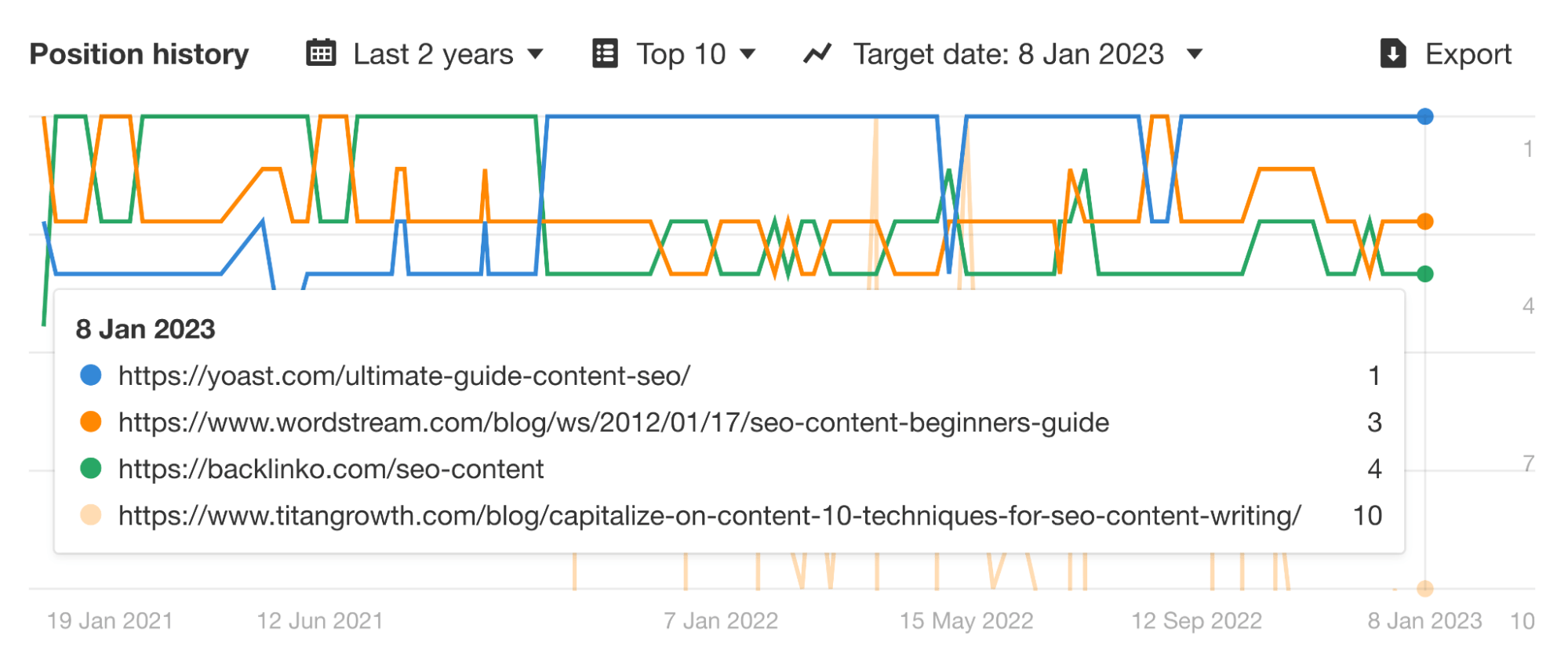
I only filtered for URLs that had the featured snippet at one point in the past two years. We can see that the rest targets “seo content” in the original order, and Backlinko claimed the first position for a long time. But we need to check whether Google was even showing the featured snippet back then.
You do that by scrolling further down in Keywords Explorer to the SERP overview. Select a date where you want to investigate the SERP for comparison. In this case, I need any SERP between July and September 2021:
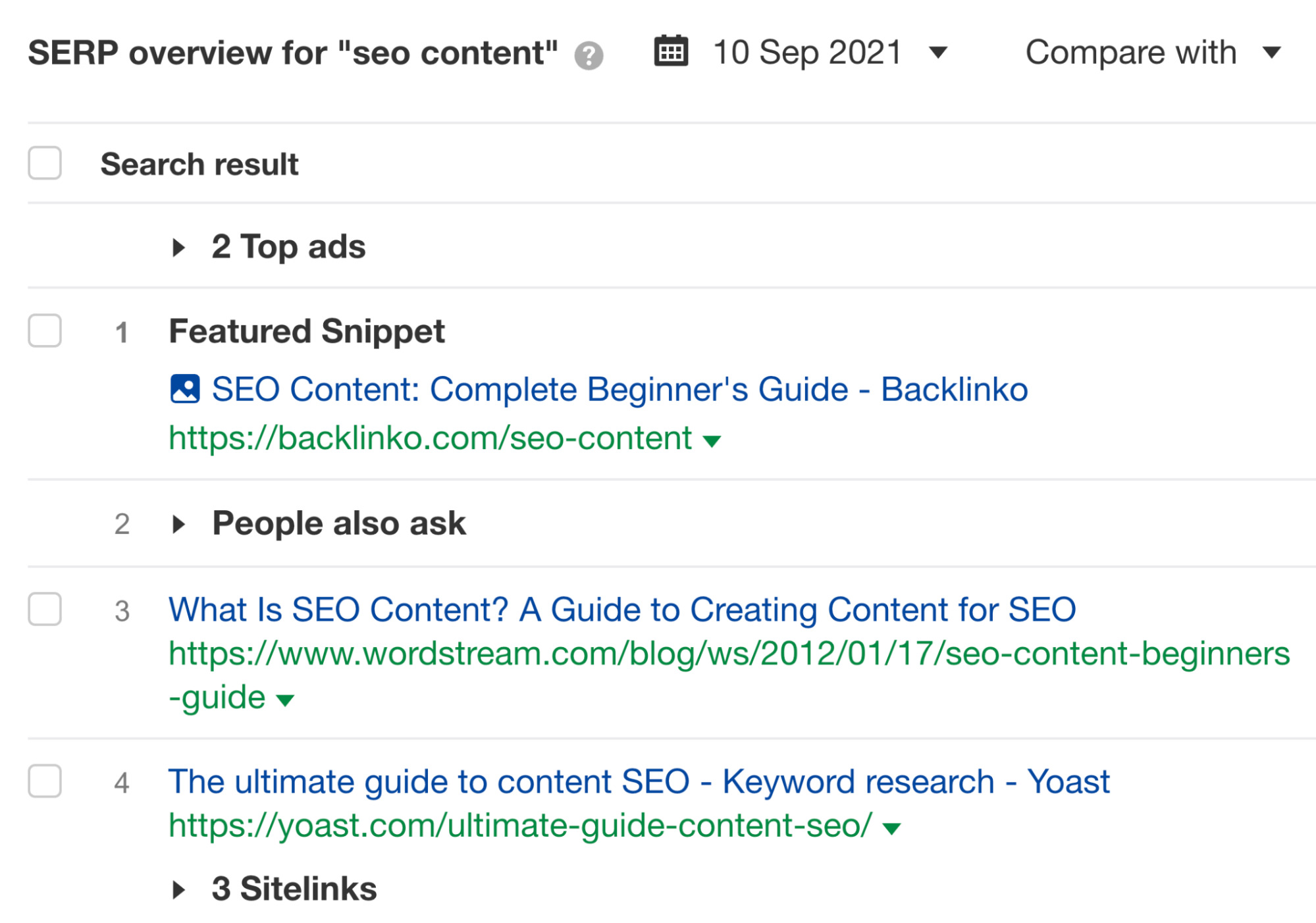
There it is: The featured snippet was there, claimed by another page. The last thing I need here is to check the section that was ranking back then by opening the URL on Archive.org after clicking on the caret:
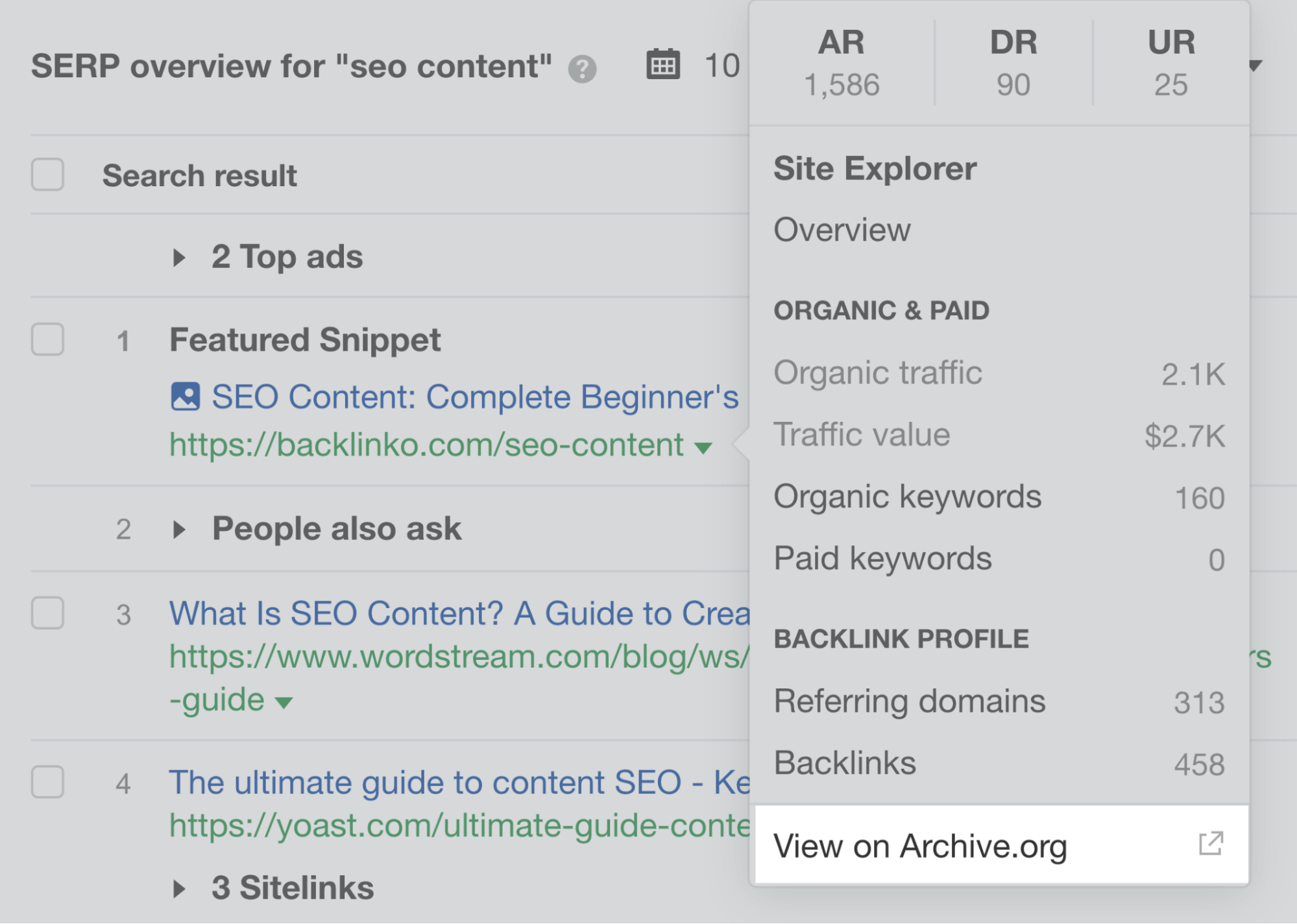
And selecting a screenshot of that page during the time it was ranking for the featured snippet:
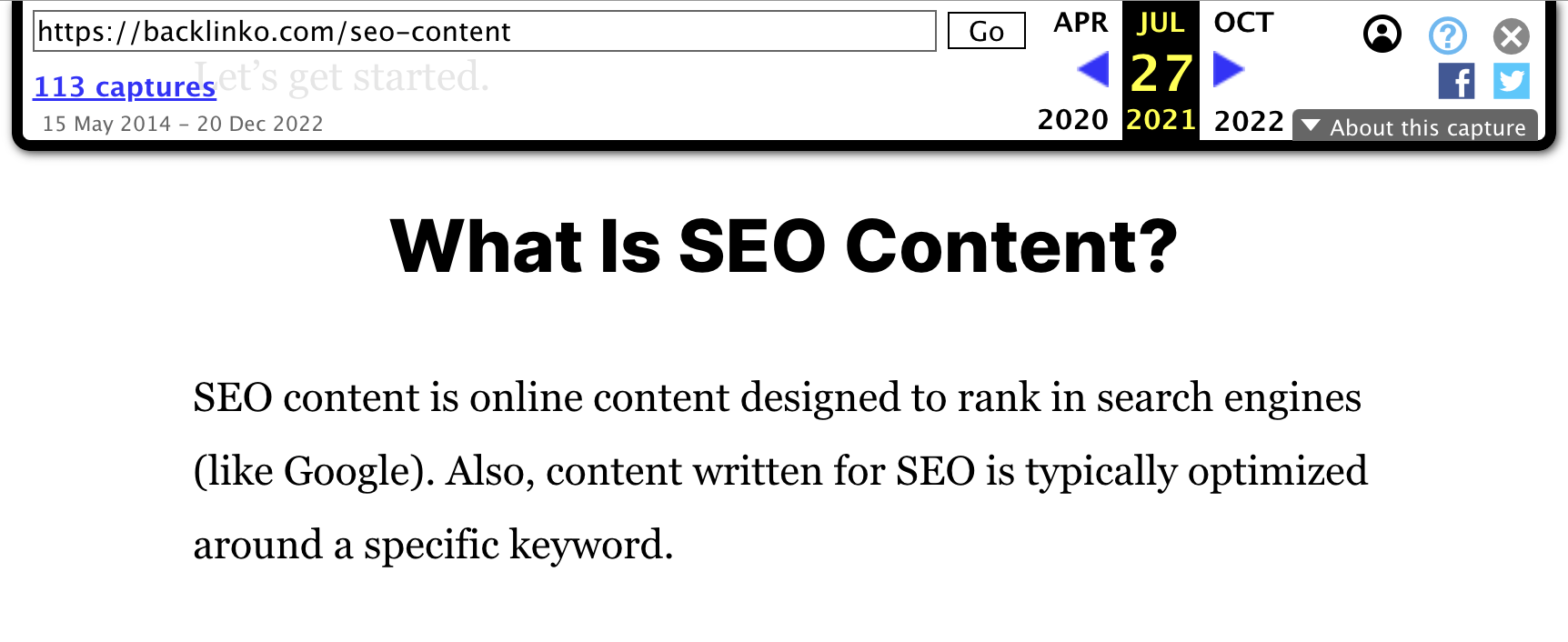
We see three rather different definitions. There’s definitely room for the featured snippet optimization. I’d make our definition a bit longer, change the second sentence, and fit in the mention of keywords because I think that’s important. I’d change it from:
SEO content is content designed to rank in search engines. It could be a blog post, product or landing page, interactive tool, or something else.
To something like this:
SEO content is content designed to rank high in search engines for a specific keyword. Creating it requires researching and covering what searchers would find valuable.
I can honestly say that I feel this definition is superior to the competing ones. That should be your ultimate goal when it comes to optimizing for featured snippets regardless of the format.
This was quite an interesting example. One last thing to note here is that your snippet-worthy information needs to be formatted in a way that Google can easily parse, understand, and interpret. A good rule of thumb is that if the reader comes across that information easily, then Google should be able to as well.
Create new content with featured snippets in mind
Let’s make one thing clear from the start: Scoring a featured snippet should be just the icing on the cake, not the main purpose of why and how you cover a certain topic.
The prerequisite for winning the featured snippet is ranking well, so that should still be the focus. For this reason, I investigate potential featured snippet opportunities only after selecting a topic.
Since the major factor of being successful in SEO is aligning with the search intent, you should always analyze the competing pages on the SERP. Let’s take our main topic here as an example because it doesn’t get better than optimizing content to win featured snippets for “featured snippets” keywords.
I have my “featured snippets” topic, and you should select yours based on your keyword research. Look it up in Ahrefs’ Keywords Explorer and scroll down to the SERP overview:
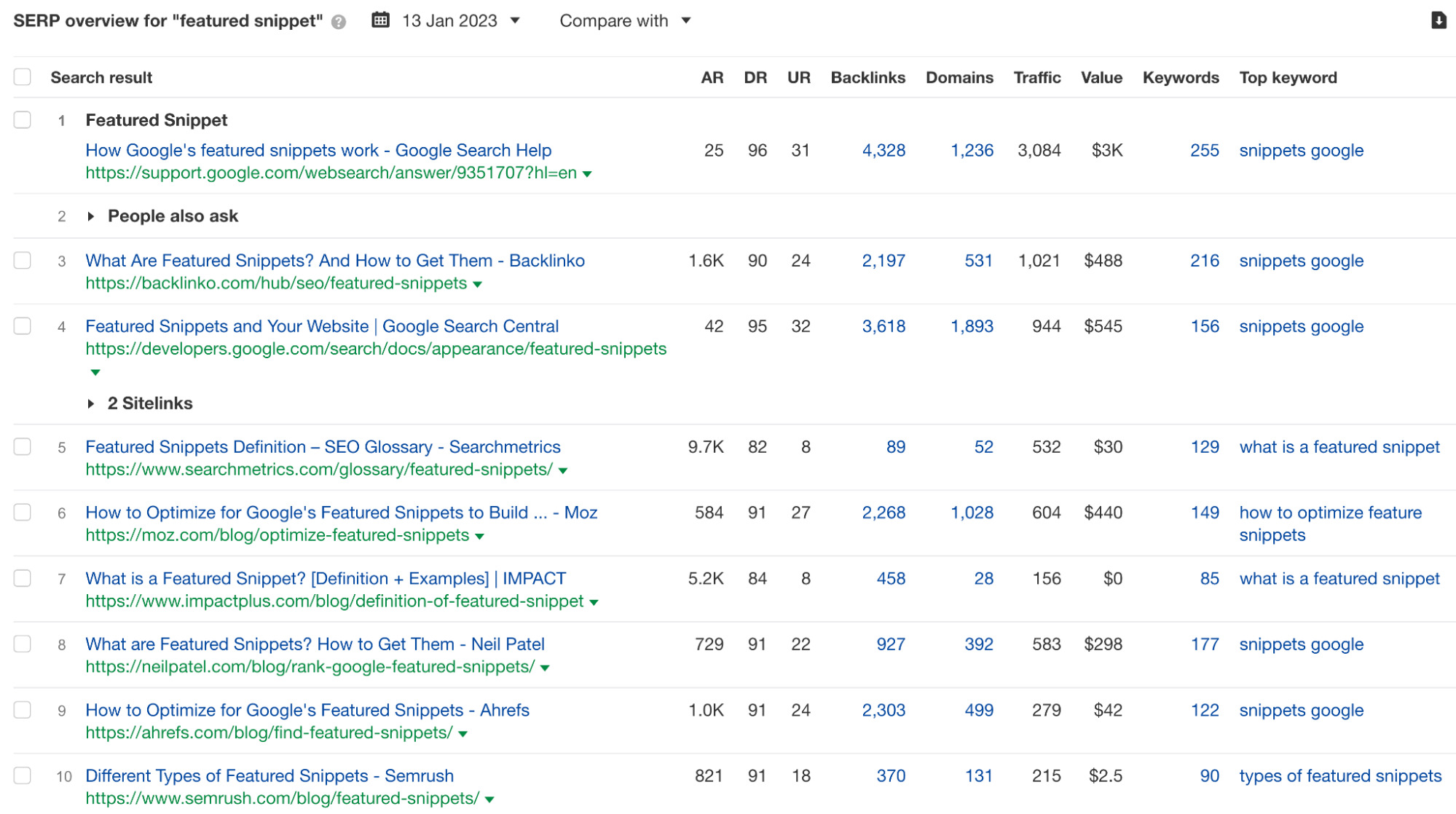
I see that the main keyword triggers a featured snippet, so I’m in the difficult position of trying to dethrone Google there:
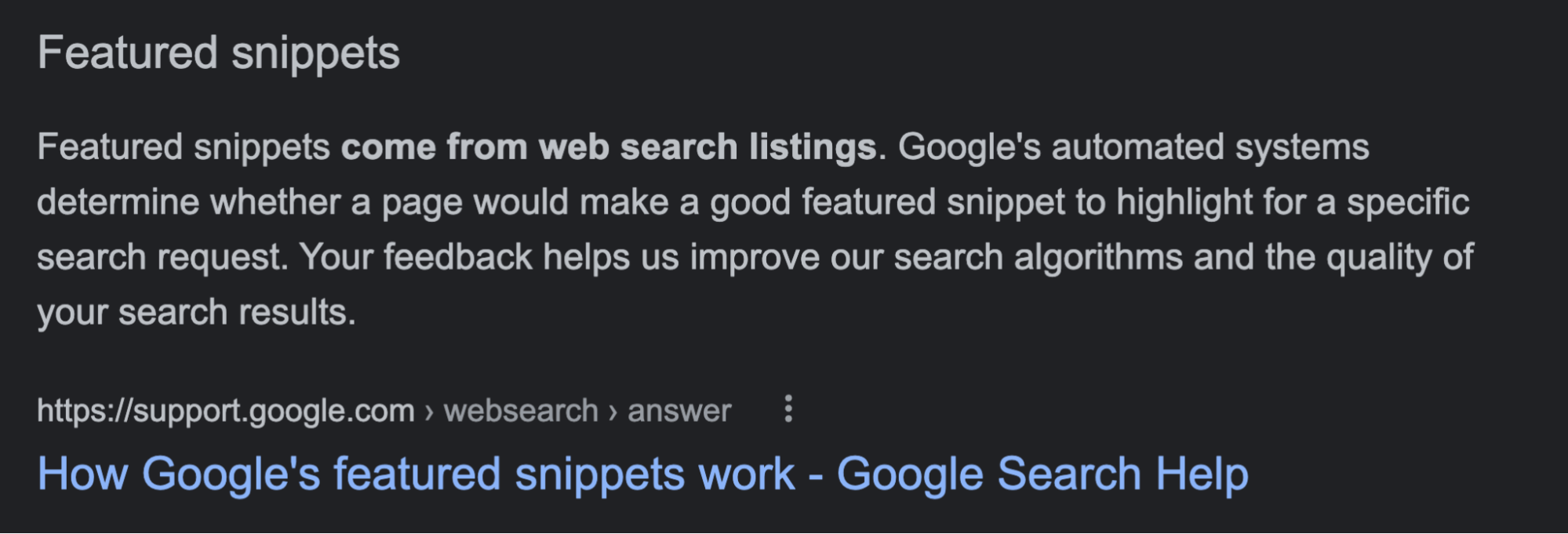
Honestly, this is a case of a bad featured snippet. It doesn’t really provide value to the searcher. I don’t learn what it is or how it works. Google has a clear advantage of coining the term, so it’s kind of a branded search. But I’ll try my best to create a definition-type paragraph that I think searchers likely want to see.
We already went through the process of creating content for the “seo content” featured snippet, so this is just a rinse-and-repeat process—provide the best answer possible using a suitable format.
Since pages can rank for thousands of keywords, there are naturally many more featured snippet opportunities than just the one for the main keyword. The easiest way to check these is to click through a few top-ranking pages to see all the keywords they rank for:
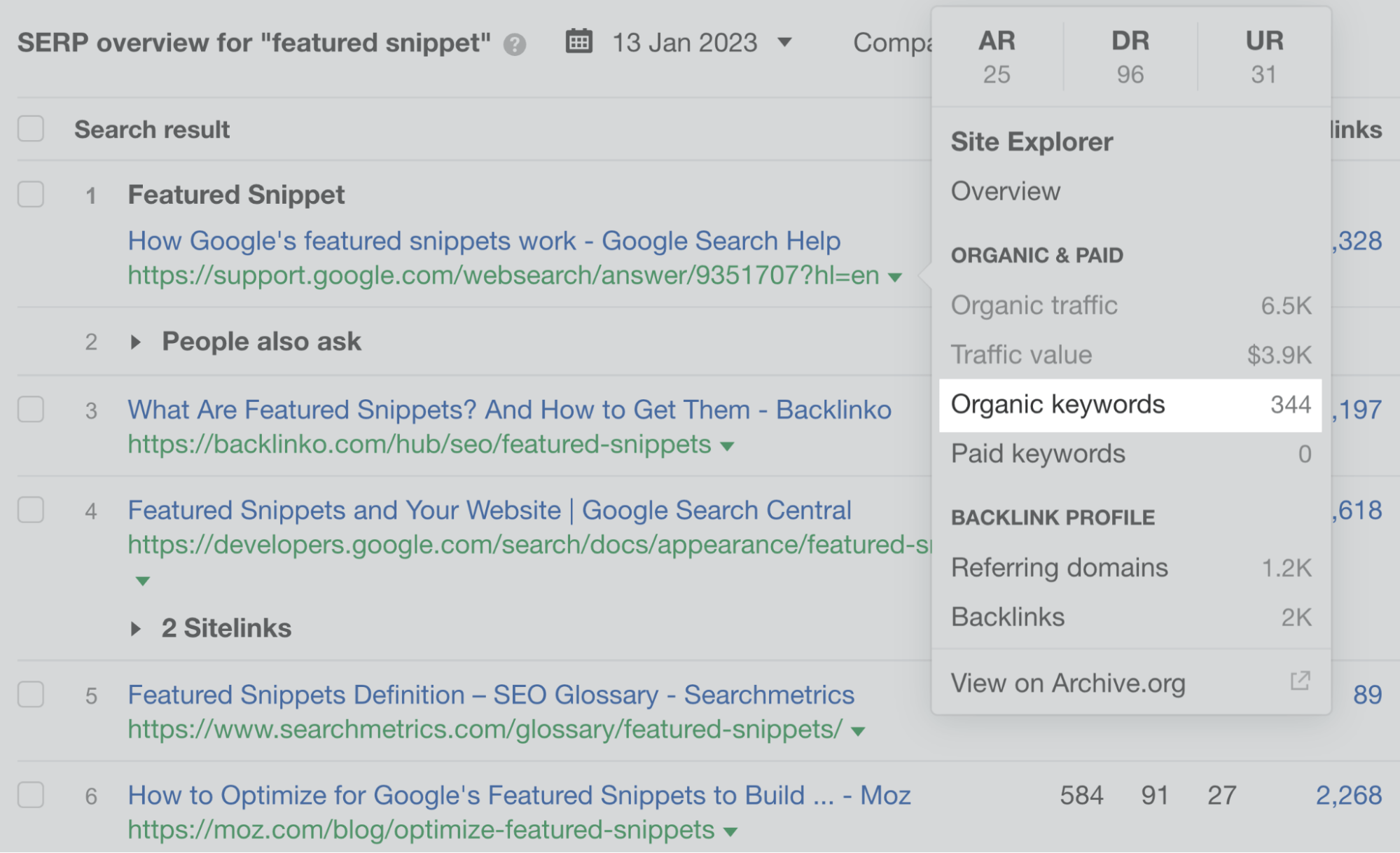
And filter the report for keywords that trigger featured snippets and have a certain minimum search volume to make it worthwhile (as we’ve already shown earlier). I also included a “1–20” Position filter to make the list as relevant as possible:
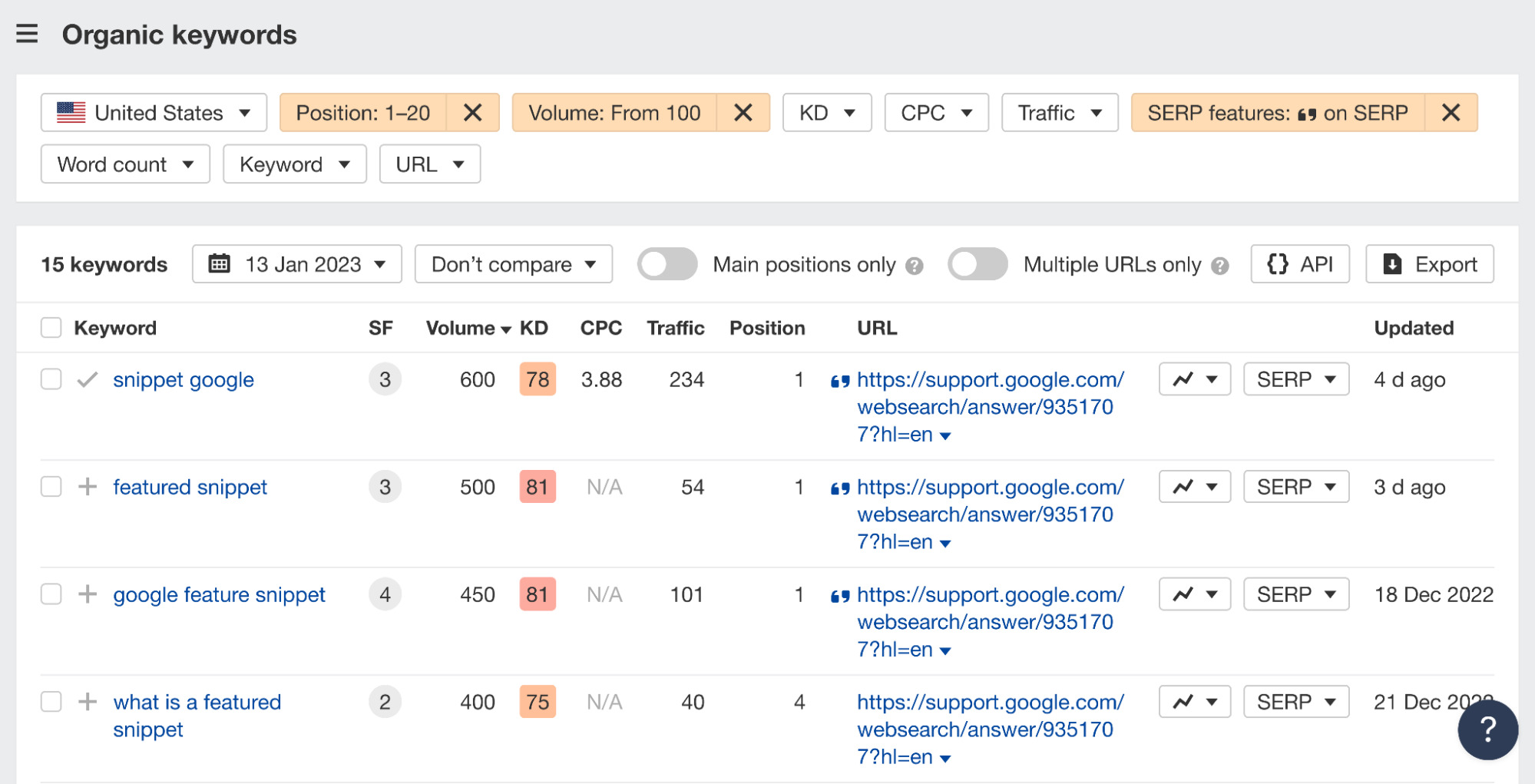
Some of those keywords will be almost the same, having the same search intent and featured snippet. I don’t need to check the featured snippets for keywords like “snippet google” or “what is a featured snippet” because the answer and optimizing your content for them remain the same.
We’re looking for keywords that can trigger different featured snippets and are aligned with sections we cover in the article. There are a bunch of these opportunities around optimizing and getting featured snippets:
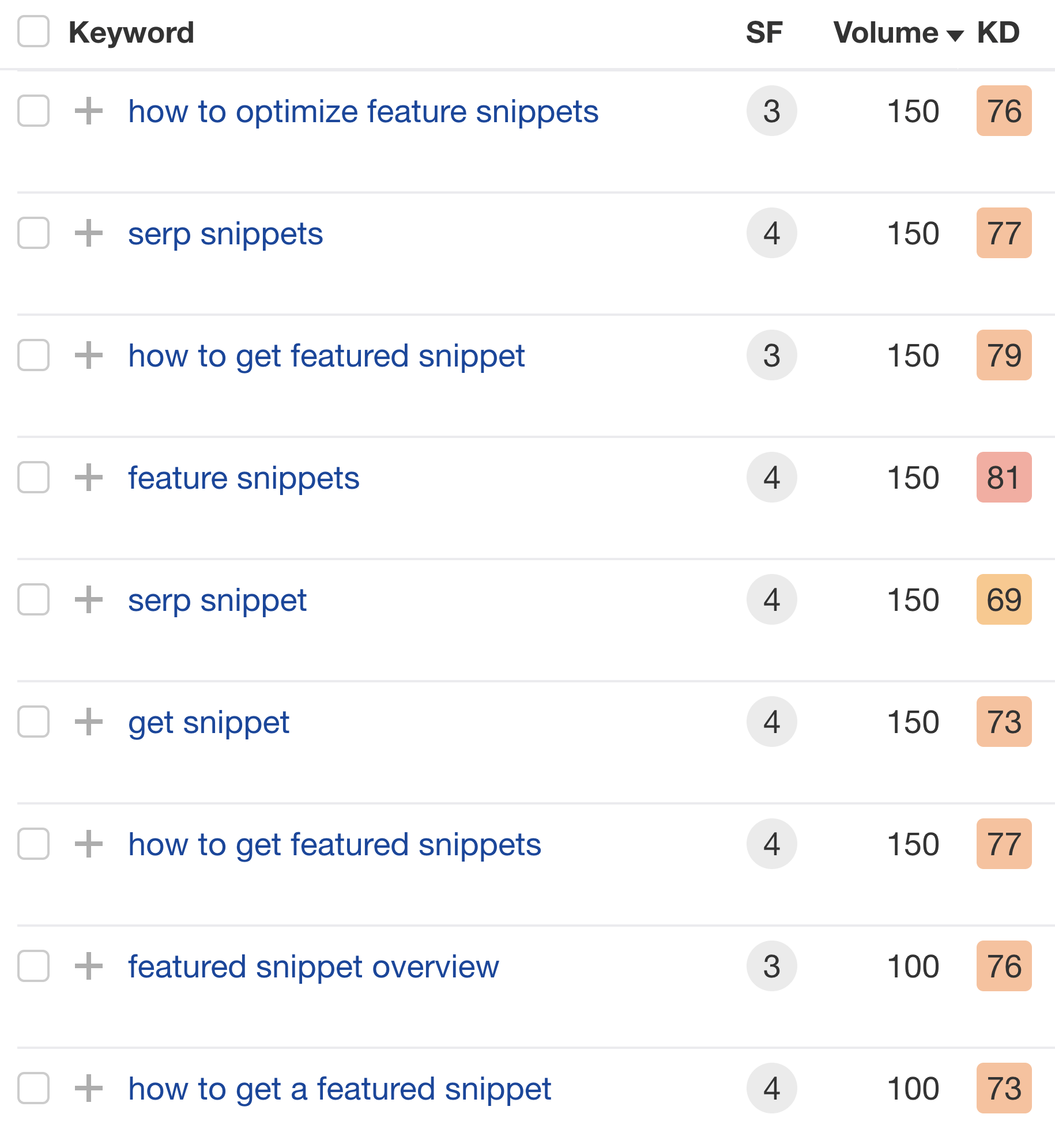
Look them up and see what Google shows there:
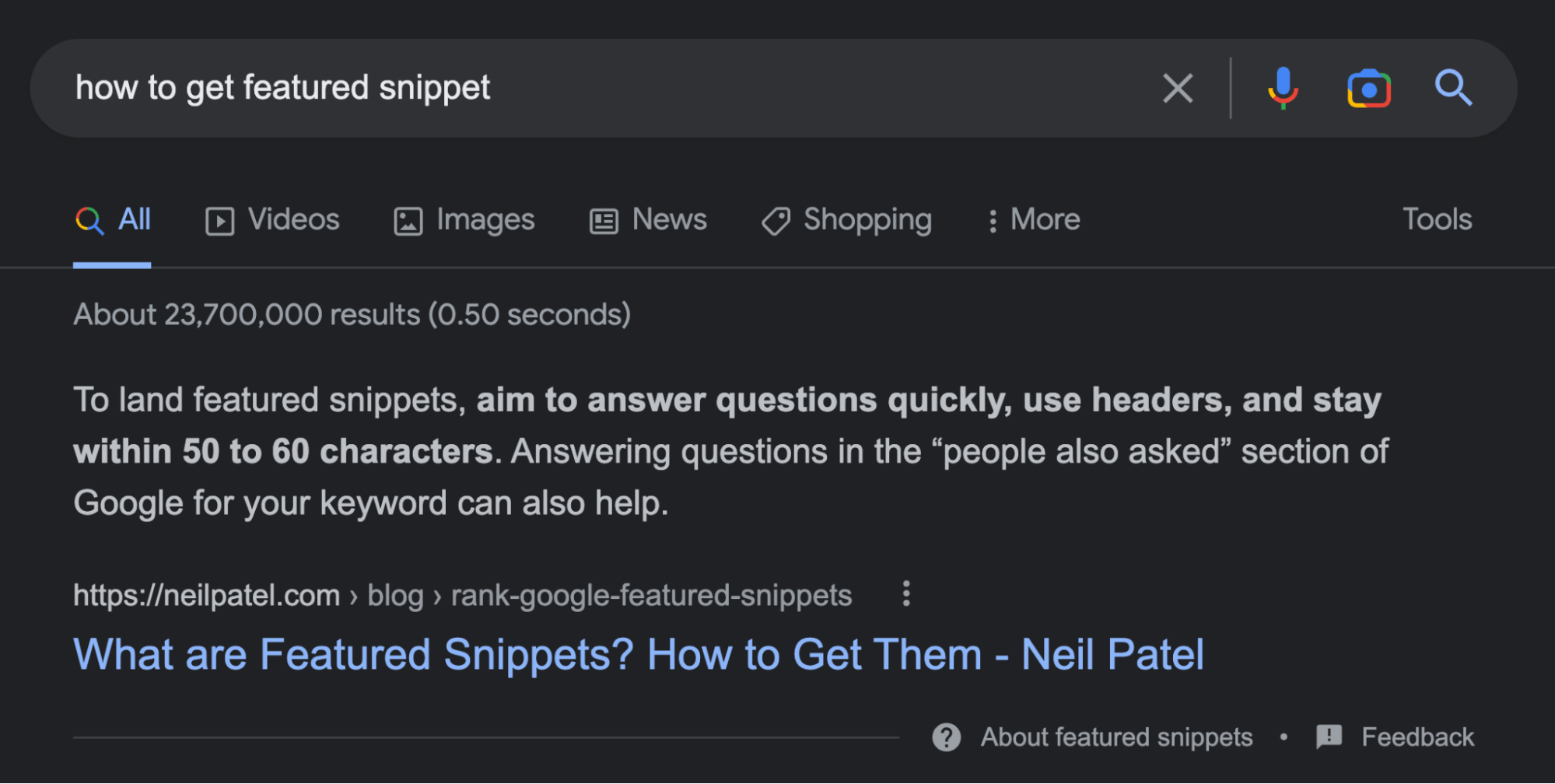
So if I want to have a chance to rank for this, I should include a straight-to-the-point paragraph on how to get a featured snippet instead of explaining the whole process across many pages. This looks like something that can fit nicely into the “Final thoughts” section to sum it up, so I’ll do that.
And since different pages rank for different keywords, it pays off to repeat this process for one to two more top-ranking pages. I found that I should also optimize for the “types of featured snippets” keyword here.
Even if you don’t end up winning the featured snippets, we’re still trying to answer searchers’ questions in the best way possible. That in itself is critical to your content’s success on the SERPs.
Here are a few copywriting tips for winning featured snippets to wrap this section up. You should:
- Format and structure your content correctly (H1–H6, etc.).
- Try to avoid overcomplicated sentences. Succinct explanations win.
- Use the language of your audience. In the end, Google uses featured snippets as answers in voice search.
- Use the ”inverted pyramid” method (where it makes sense).
pro tip
First, it’s a good idea to do so regardless of featured snippets because it can enhance your plain search result into a rich snippet. But I’ve also seen such pages dominate the combined featured snippets with PAA boxes where everything was from a single source.
Getting a featured snippet is equal to ranking first for a keyword. You may already be tracking keyword ranking positions, so let me help you expand it to tracking featured snippets.
Enter Ahrefs’ Rank Tracker.
First of all, I track all important keywords regardless of their SERP features. But we can begin by adding the most important keywords that also trigger featured snippets.
You can do that in a few clicks through the Organic keywords report we’ve already shown multiple times here. You just have to create a Rank Tracking project first for it to appear here:
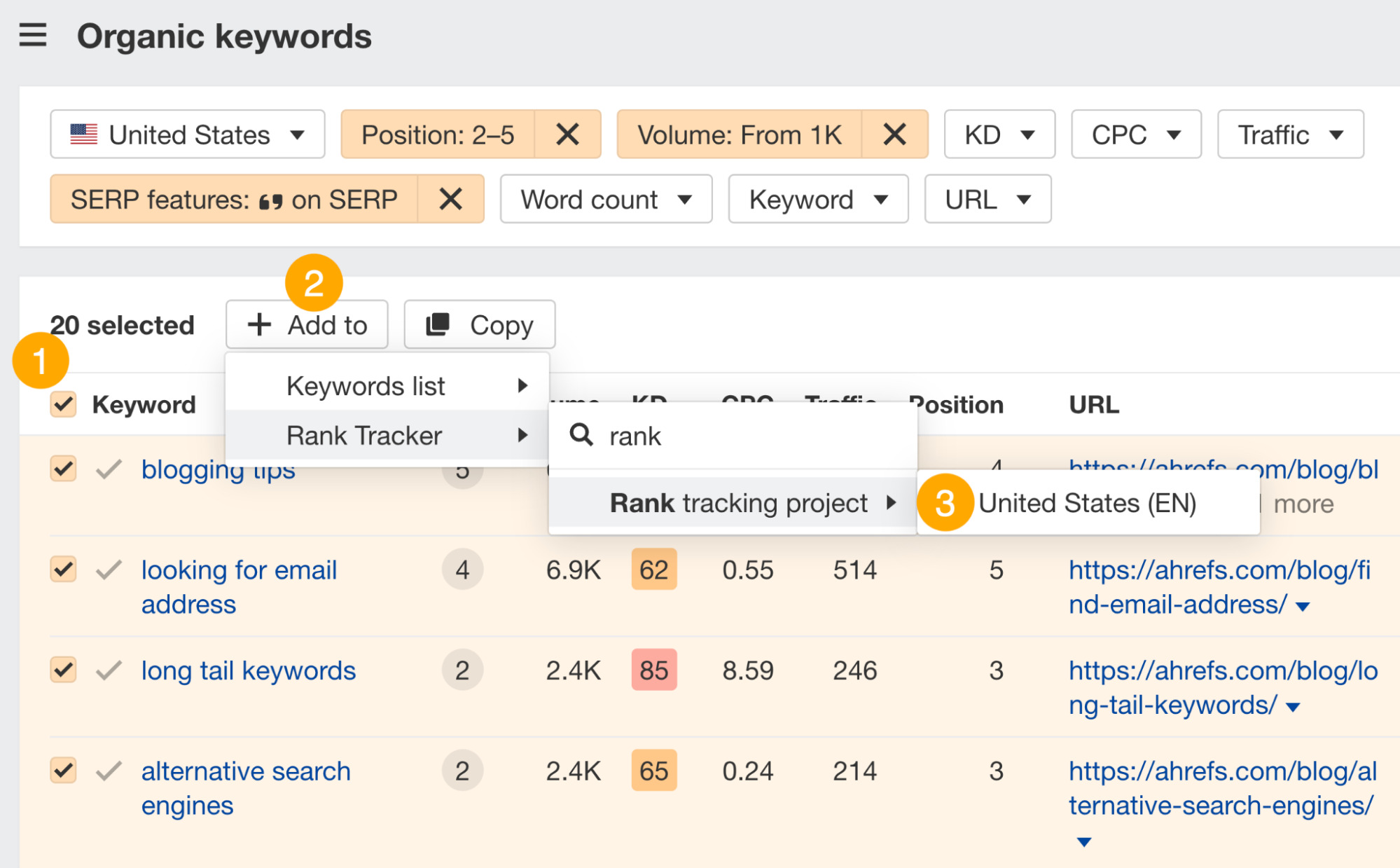
You’re all set to see when you win or lose a featured snippet. Go to the Rank Tracker’s Overview report, click on the “SERP features” tab, and check the “Featured snippet” row:
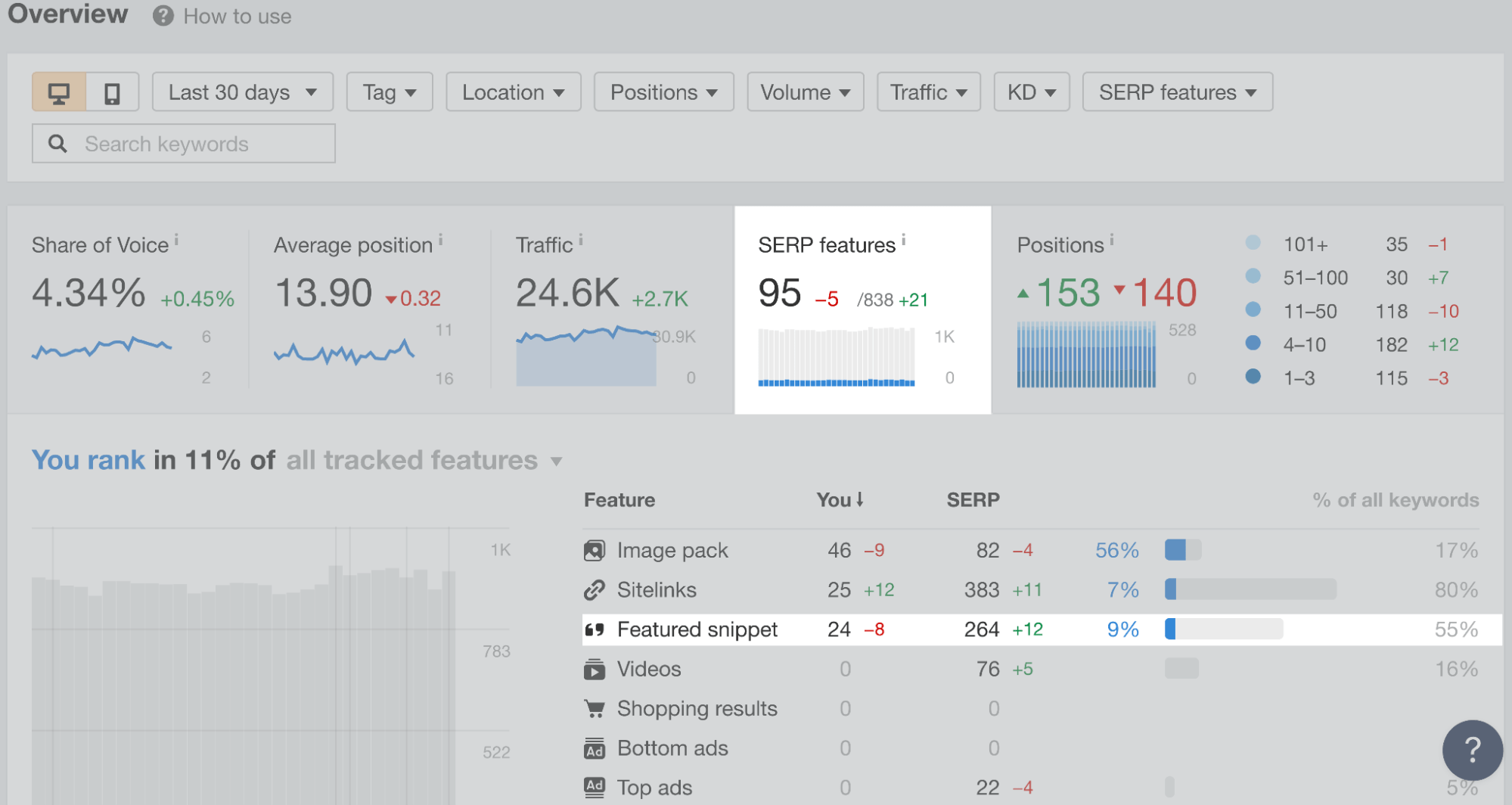
As you can see, from the keywords I’m tracking, the project lost eight featured snippets, while 12 new ones appeared on the SERP over the tracked time period (last 30 days).
Here are the key parts to keep an eye on:
- Number of featured snippets you currently own (plus the +/- change in the selected period)
- Number of featured snippets in total for the keywords you’re tracking (plus the +/- change for the period)
- Percentage of all the featured snippets among the tracked keywords that you own (9%, in this example)
You can also change the view from “all tracked features” to “featured snippets” to see your progress over time:
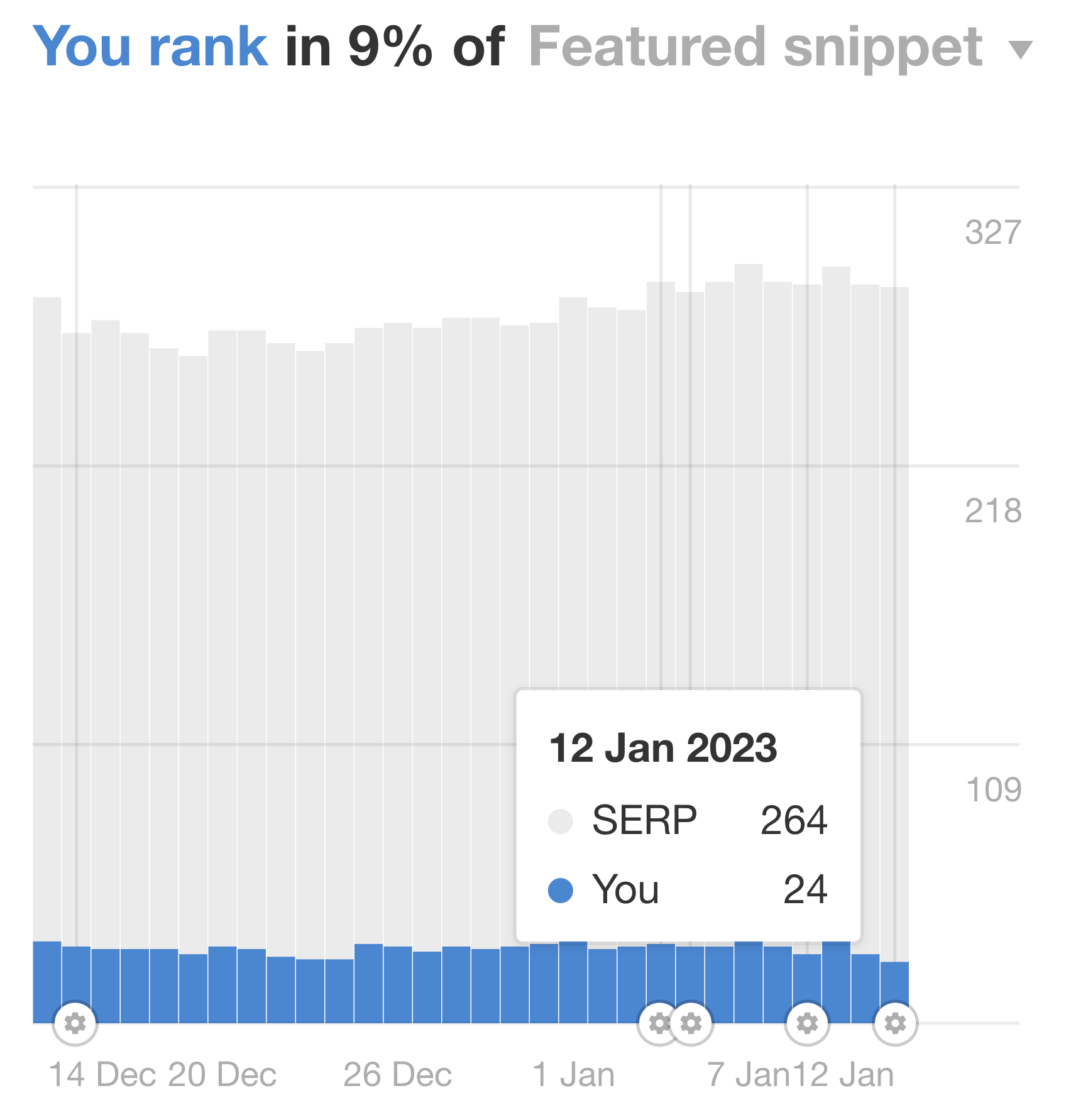
To delve deeper into the specifics on the keyword level, select the “Featured snippet” filter:
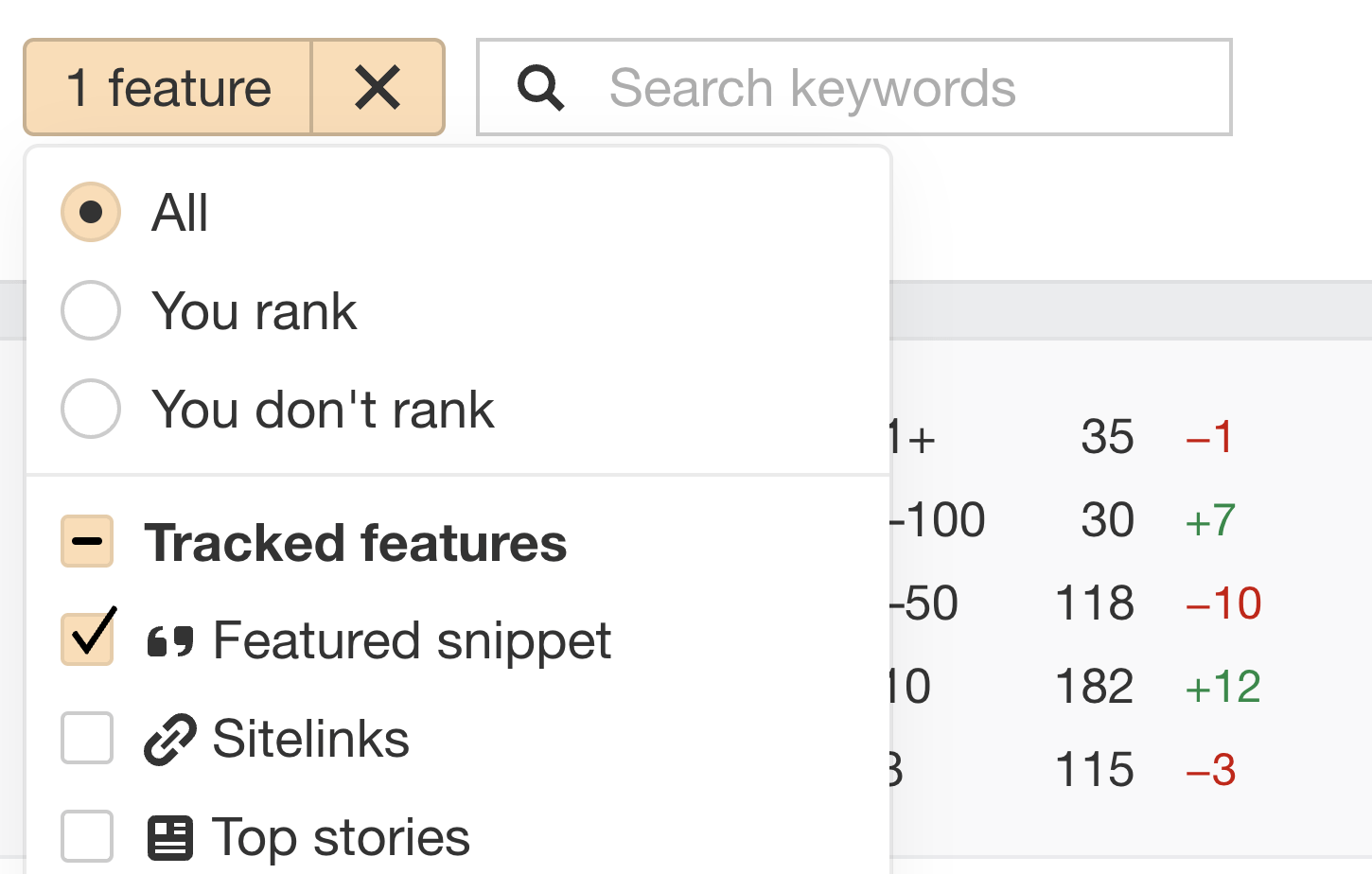
And scroll down to the keywords list to see the time comparison data (30 days, in this example):
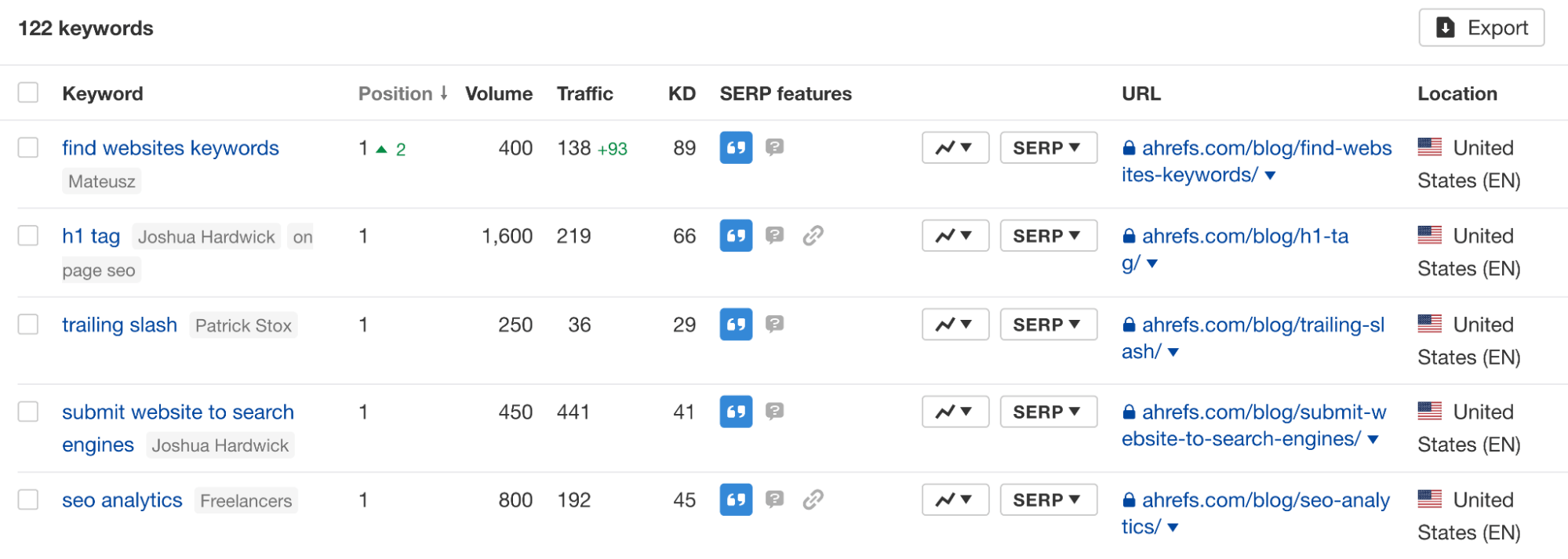
We can see that the top keyword is among our new featured snippets. But it is more helpful to isolate the featured snippet movements only.
To isolate the winning cases, we’ll need to apply two filters:
- Position – Improved (you rank higher than at the start of your selected period).
- SERP features – You rank for the featured snippet.
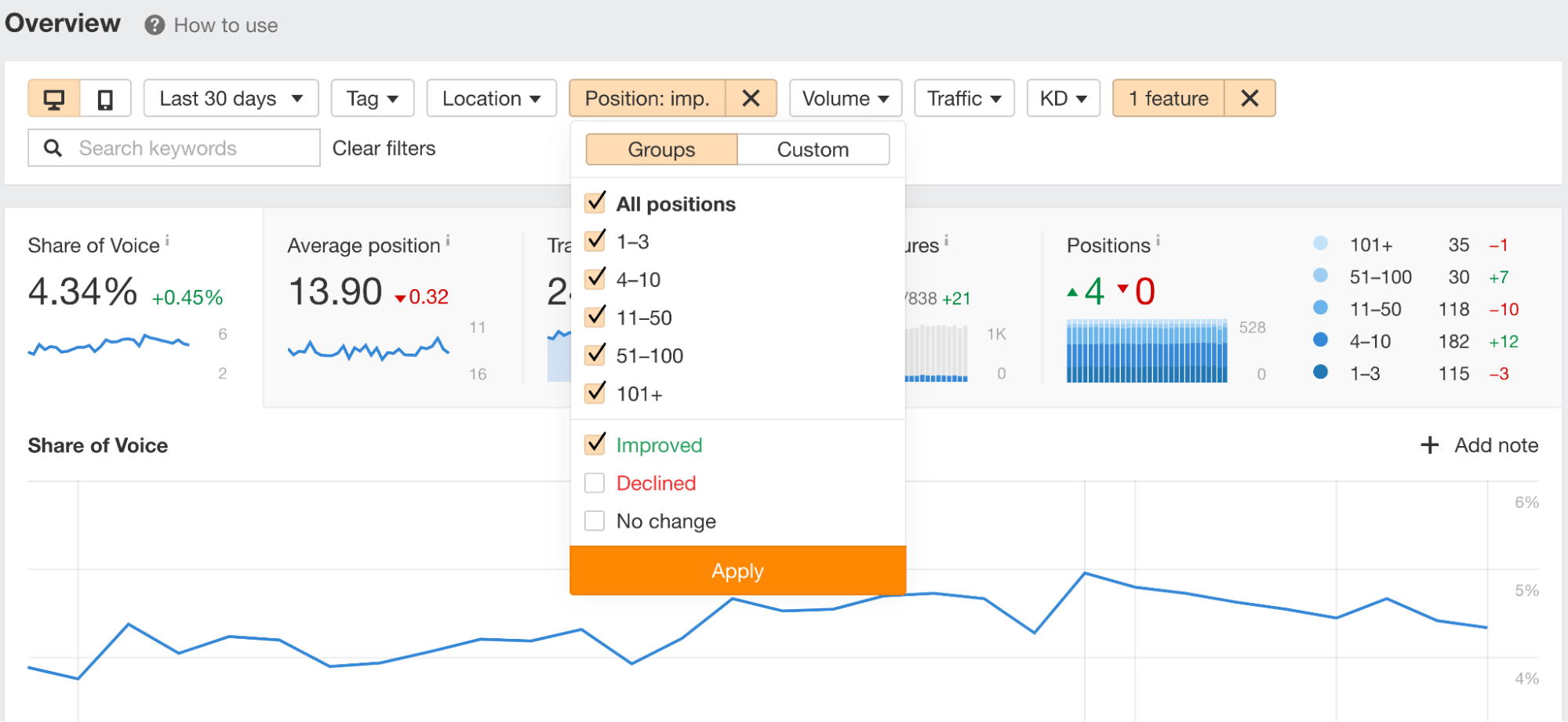
Again, scroll down and see the featured snippet winners of the month (or whatever period you choose):
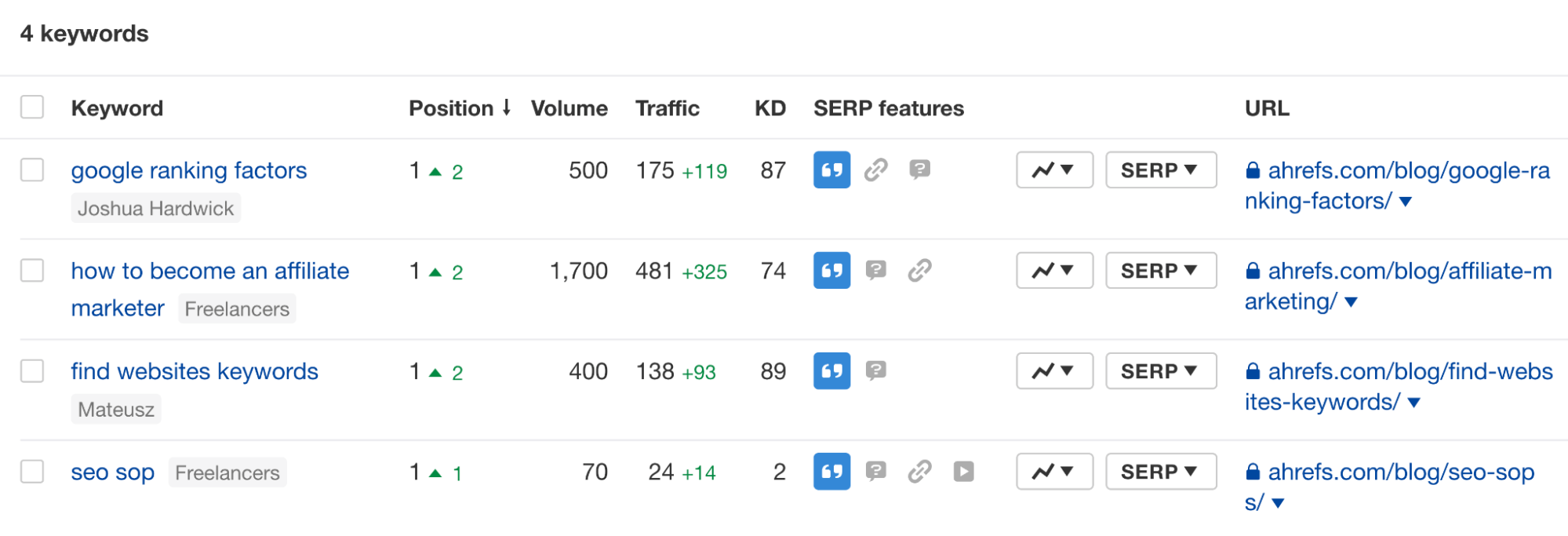
To see lost featured snippets, just apply reverse filters -> decline in positions in the top 10 and only show featured snippets that you don’t own. Unfortunately, you can’t currently isolate cases where you lost the snippet, so you’ll see all declines in the top 10.
Look for keywords that dropped from the first position, like these first two:
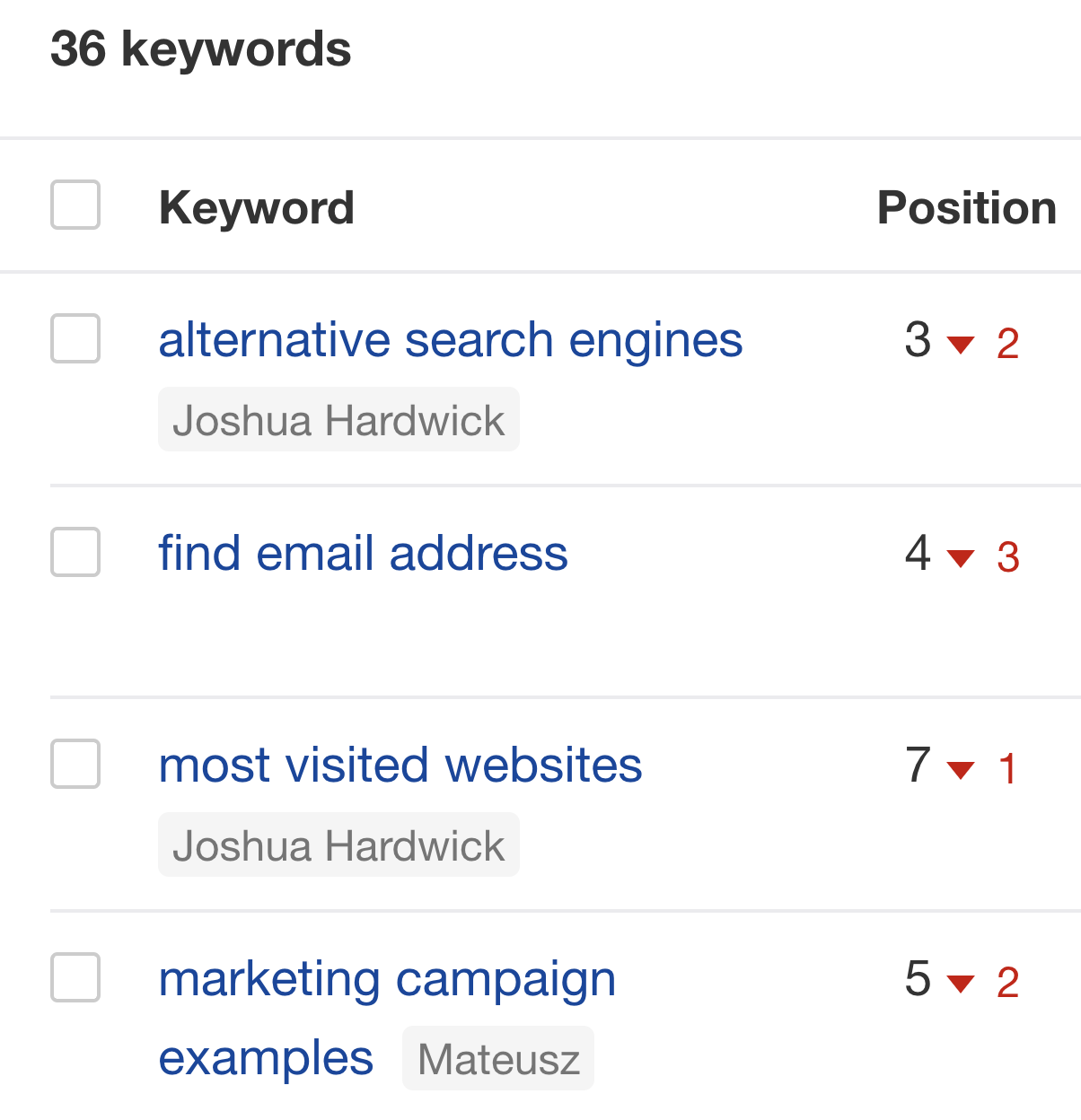
You may want to consider checking the position drops regardless of featured snippets anyway. Sort the table by traffic and pay attention to huge traffic drops.
Final thoughts
You should now know everything necessary to win those coveted SERP jumps to the first position. To sum it up:
Optimizing for featured snippets is about providing a brief and valuable answer to the search query in the most suitable format. Getting the featured snippet involves following all the best SEO practices to make the content rank well for the target keyword.
If you have any comments or questions, don’t hesitate to ping me on Twitter.
SEO
How To Write ChatGPT Prompts To Get The Best Results

ChatGPT is a game changer in the field of SEO. This powerful language model can generate human-like content, making it an invaluable tool for SEO professionals.
However, the prompts you provide largely determine the quality of the output.
To unlock the full potential of ChatGPT and create content that resonates with your audience and search engines, writing effective prompts is crucial.
In this comprehensive guide, we’ll explore the art of writing prompts for ChatGPT, covering everything from basic techniques to advanced strategies for layering prompts and generating high-quality, SEO-friendly content.
Writing Prompts For ChatGPT
What Is A ChatGPT Prompt?
A ChatGPT prompt is an instruction or discussion topic a user provides for the ChatGPT AI model to respond to.
The prompt can be a question, statement, or any other stimulus to spark creativity, reflection, or engagement.
Users can use the prompt to generate ideas, share their thoughts, or start a conversation.
ChatGPT prompts are designed to be open-ended and can be customized based on the user’s preferences and interests.
How To Write Prompts For ChatGPT
Start by giving ChatGPT a writing prompt, such as, “Write a short story about a person who discovers they have a superpower.”
ChatGPT will then generate a response based on your prompt. Depending on the prompt’s complexity and the level of detail you requested, the answer may be a few sentences or several paragraphs long.
Use the ChatGPT-generated response as a starting point for your writing. You can take the ideas and concepts presented in the answer and expand upon them, adding your own unique spin to the story.
If you want to generate additional ideas, try asking ChatGPT follow-up questions related to your original prompt.
For example, you could ask, “What challenges might the person face in exploring their newfound superpower?” Or, “How might the person’s relationships with others be affected by their superpower?”
Remember that ChatGPT’s answers are generated by artificial intelligence and may not always be perfect or exactly what you want.
However, they can still be a great source of inspiration and help you start writing.
Must-Have GPTs Assistant
I recommend installing the WebBrowser Assistant created by the OpenAI Team. This tool allows you to add relevant Bing results to your ChatGPT prompts.
This assistant adds the first web results to your ChatGPT prompts for more accurate and up-to-date conversations.
It is very easy to install in only two clicks. (Click on Start Chat.)
For example, if I ask, “Who is Vincent Terrasi?,” ChatGPT has no answer.
With WebBrower Assistant, the assistant creates a new prompt with the first Bing results, and now ChatGPT knows who Vincent Terrasi is.
 Screenshot from ChatGPT, March 2023
Screenshot from ChatGPT, March 2023You can test other GPT assistants available in the GPTs search engine if you want to use Google results.
Master Reverse Prompt Engineering
ChatGPT can be an excellent tool for reverse engineering prompts because it generates natural and engaging responses to any given input.
By analyzing the prompts generated by ChatGPT, it is possible to gain insight into the model’s underlying thought processes and decision-making strategies.
One key benefit of using ChatGPT to reverse engineer prompts is that the model is highly transparent in its decision-making.
This means that the reasoning and logic behind each response can be traced, making it easier to understand how the model arrives at its conclusions.
Once you’ve done this a few times for different types of content, you’ll gain insight into crafting more effective prompts.
Prepare Your ChatGPT For Generating Prompts
First, activate the reverse prompt engineering.
- Type the following prompt: “Enable Reverse Prompt Engineering? By Reverse Prompt Engineering I mean creating a prompt from a given text.”
 Screenshot from ChatGPT, March 2023
Screenshot from ChatGPT, March 2023ChatGPT is now ready to generate your prompt. You can test the product description in a new chatbot session and evaluate the generated prompt.
- Type: “Create a very technical reverse prompt engineering template for a product description about iPhone 11.”
 Screenshot from ChatGPT, March 2023
Screenshot from ChatGPT, March 2023The result is amazing. You can test with a full text that you want to reproduce. Here is an example of a prompt for selling a Kindle on Amazon.
- Type: “Reverse Prompt engineer the following {product), capture the writing style and the length of the text :
product =”
 Screenshot from ChatGPT, March 2023
Screenshot from ChatGPT, March 2023I tested it on an SEJ blog post. Enjoy the analysis – it is excellent.
- Type: “Reverse Prompt engineer the following {text}, capture the tone and writing style of the {text} to include in the prompt :
text = all text coming from https://www.searchenginejournal.com/google-bard-training-data/478941/”
 Screenshot from ChatGPT, March 2023
Screenshot from ChatGPT, March 2023But be careful not to use ChatGPT to generate your texts. It is just a personal assistant.
Go Deeper
Prompts and examples for SEO:
- Keyword research and content ideas prompt: “Provide a list of 20 long-tail keyword ideas related to ‘local SEO strategies’ along with brief content topic descriptions for each keyword.”
- Optimizing content for featured snippets prompt: “Write a 40-50 word paragraph optimized for the query ‘what is the featured snippet in Google search’ that could potentially earn the featured snippet.”
- Creating meta descriptions prompt: “Draft a compelling meta description for the following blog post title: ’10 Technical SEO Factors You Can’t Ignore in 2024′.”
Important Considerations:
- Always Fact-Check: While ChatGPT can be a helpful tool, it’s crucial to remember that it may generate inaccurate or fabricated information. Always verify any facts, statistics, or quotes generated by ChatGPT before incorporating them into your content.
- Maintain Control and Creativity: Use ChatGPT as a tool to assist your writing, not replace it. Don’t rely on it to do your thinking or create content from scratch. Your unique perspective and creativity are essential for producing high-quality, engaging content.
- Iteration is Key: Refine and revise the outputs generated by ChatGPT to ensure they align with your voice, style, and intended message.
Additional Prompts for Rewording and SEO:
– Rewrite this sentence to be more concise and impactful.
– Suggest alternative phrasing for this section to improve clarity.
– Identify opportunities to incorporate relevant internal and external links.
– Analyze the keyword density and suggest improvements for better SEO.
Remember, while ChatGPT can be a valuable tool, it’s essential to use it responsibly and maintain control over your content creation process.
Experiment And Refine Your Prompting Techniques
Writing effective prompts for ChatGPT is an essential skill for any SEO professional who wants to harness the power of AI-generated content.
Hopefully, the insights and examples shared in this article can inspire you and help guide you to crafting stronger prompts that yield high-quality content.
Remember to experiment with layering prompts, iterating on the output, and continually refining your prompting techniques.
This will help you stay ahead of the curve in the ever-changing world of SEO.
More resources:
Featured Image: Tapati Rinchumrus/Shutterstock
SEO
Measuring Content Impact Across The Customer Journey

Understanding the impact of your content at every touchpoint of the customer journey is essential – but that’s easier said than done. From attracting potential leads to nurturing them into loyal customers, there are many touchpoints to look into.
So how do you identify and take advantage of these opportunities for growth?
Watch this on-demand webinar and learn a comprehensive approach for measuring the value of your content initiatives, so you can optimize resource allocation for maximum impact.
You’ll learn:
- Fresh methods for measuring your content’s impact.
- Fascinating insights using first-touch attribution, and how it differs from the usual last-touch perspective.
- Ways to persuade decision-makers to invest in more content by showcasing its value convincingly.
With Bill Franklin and Oliver Tani of DAC Group, we unravel the nuances of attribution modeling, emphasizing the significance of layering first-touch and last-touch attribution within your measurement strategy.
Check out these insights to help you craft compelling content tailored to each stage, using an approach rooted in first-hand experience to ensure your content resonates.
Whether you’re a seasoned marketer or new to content measurement, this webinar promises valuable insights and actionable tactics to elevate your SEO game and optimize your content initiatives for success.
View the slides below or check out the full webinar for all the details.
SEO
How to Find and Use Competitor Keywords

Competitor keywords are the keywords your rivals rank for in Google’s search results. They may rank organically or pay for Google Ads to rank in the paid results.
Knowing your competitors’ keywords is the easiest form of keyword research. If your competitors rank for or target particular keywords, it might be worth it for you to target them, too.
There is no way to see your competitors’ keywords without a tool like Ahrefs, which has a database of keywords and the sites that rank for them. As far as we know, Ahrefs has the biggest database of these keywords.
How to find all the keywords your competitor ranks for
- Go to Ahrefs’ Site Explorer
- Enter your competitor’s domain
- Go to the Organic keywords report
The report is sorted by traffic to show you the keywords sending your competitor the most visits. For example, Mailchimp gets most of its organic traffic from the keyword “mailchimp.”


Since you’re unlikely to rank for your competitor’s brand, you might want to exclude branded keywords from the report. You can do this by adding a Keyword > Doesn’t contain filter. In this example, we’ll filter out keywords containing “mailchimp” or any potential misspellings:


If you’re a new brand competing with one that’s established, you might also want to look for popular low-difficulty keywords. You can do this by setting the Volume filter to a minimum of 500 and the KD filter to a maximum of 10.


How to find keywords your competitor ranks for, but you don’t
- Go to Competitive Analysis
- Enter your domain in the This target doesn’t rank for section
- Enter your competitor’s domain in the But these competitors do section


Hit “Show keyword opportunities,” and you’ll see all the keywords your competitor ranks for, but you don’t.


You can also add a Volume and KD filter to find popular, low-difficulty keywords in this report.


How to find keywords multiple competitors rank for, but you don’t
- Go to Competitive Analysis
- Enter your domain in the This target doesn’t rank for section
- Enter the domains of multiple competitors in the But these competitors do section


You’ll see all the keywords that at least one of these competitors ranks for, but you don’t.


You can also narrow the list down to keywords that all competitors rank for. Click on the Competitors’ positions filter and choose All 3 competitors:


- Go to Ahrefs’ Site Explorer
- Enter your competitor’s domain
- Go to the Paid keywords report


This report shows you the keywords your competitors are targeting via Google Ads.
Since your competitor is paying for traffic from these keywords, it may indicate that they’re profitable for them—and could be for you, too.
You know what keywords your competitors are ranking for or bidding on. But what do you do with them? There are basically three options.
1. Create pages to target these keywords
You can only rank for keywords if you have content about them. So, the most straightforward thing you can do for competitors’ keywords you want to rank for is to create pages to target them.
However, before you do this, it’s worth clustering your competitor’s keywords by Parent Topic. This will group keywords that mean the same or similar things so you can target them all with one page.
Here’s how to do that:
- Export your competitor’s keywords, either from the Organic Keywords or Content Gap report
- Paste them into Keywords Explorer
- Click the “Clusters by Parent Topic” tab


For example, MailChimp ranks for keywords like “what is digital marketing” and “digital marketing definition.” These and many others get clustered under the Parent Topic of “digital marketing” because people searching for them are all looking for the same thing: a definition of digital marketing. You only need to create one page to potentially rank for all these keywords.


2. Optimize existing content by filling subtopics
You don’t always need to create new content to rank for competitors’ keywords. Sometimes, you can optimize the content you already have to rank for them.
How do you know which keywords you can do this for? Try this:
- Export your competitor’s keywords
- Paste them into Keywords Explorer
- Click the “Clusters by Parent Topic” tab
- Look for Parent Topics you already have content about
For example, if we analyze our competitor, we can see that seven keywords they rank for fall under the Parent Topic of “press release template.”


If we search our site, we see that we already have a page about this topic.


If we click the caret and check the keywords in the cluster, we see keywords like “press release example” and “press release format.”


To rank for the keywords in the cluster, we can probably optimize the page we already have by adding sections about the subtopics of “press release examples” and “press release format.”
3. Target these keywords with Google Ads
Paid keywords are the simplest—look through the report and see if there are any relevant keywords you might want to target, too.
For example, Mailchimp is bidding for the keyword “how to create a newsletter.”


If you’re ConvertKit, you may also want to target this keyword since it’s relevant.
If you decide to target the same keyword via Google Ads, you can hover over the magnifying glass to see the ads your competitor is using.


You can also see the landing page your competitor directs ad traffic to under the URL column.


Learn more
Check out more tutorials on how to do competitor keyword analysis:
-

 PPC6 days ago
PPC6 days ago19 Best SEO Tools in 2024 (For Every Use Case)
-

 MARKETING6 days ago
MARKETING6 days agoEcommerce evolution: Blurring the lines between B2B and B2C
-
SEARCHENGINES6 days ago
Daily Search Forum Recap: April 18, 2024
-
SEARCHENGINES5 days ago
Daily Search Forum Recap: April 19, 2024
-

 WORDPRESS5 days ago
WORDPRESS5 days agoHow to Make $5000 of Passive Income Every Month in WordPress
-

 SEO6 days ago
SEO6 days ago2024 WordPress Vulnerability Report Shows Errors Sites Keep Making
-

 WORDPRESS6 days ago
WORDPRESS6 days ago10 Amazing WordPress Design Resouces – WordPress.com News
-
WORDPRESS7 days ago
[GET] The7 Website And Ecommerce Builder For WordPress
















You must be logged in to post a comment Login